














An elderly woman with hearing loss came to my clinic for a second opinion, after she had recently been to a hearing aid sales person. I found the cause of her hearing loss was simply the fact that she had build-up of wax in her ears, the salesperson had failed to inspect them. You might be surprised how often this happens!
Here are some things to do to avoid getting ripped off:
1. A visit to the GP may save you from being ‘sold’ something when your only problem is wax in your ears.
2. Look for someone who is independent and can offer you unbiased advice, not just give you a sales pitch.
3. There are a range of hearing aid prices. Finding the right hearing aid might save you money and it will also give you the best chance of success.
4. Hearing aids can be expensive.

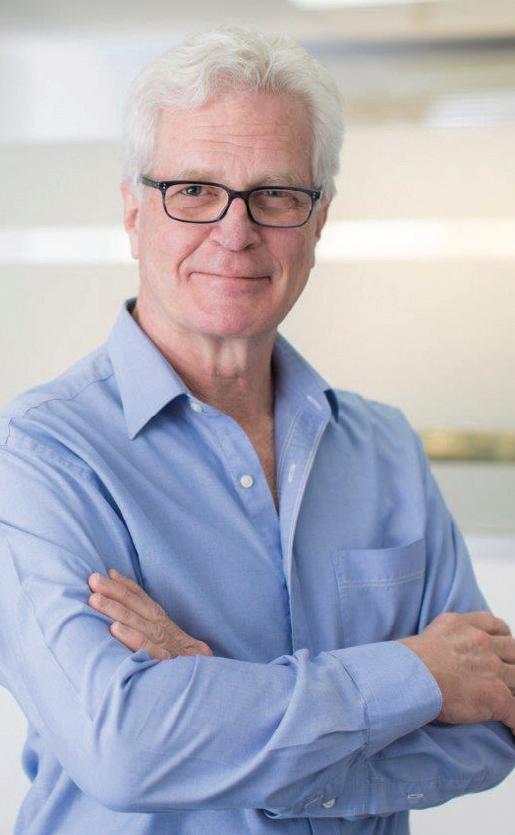
Recently I was told by two different patients that they were quoted $16,000 for a pair of hearing aids. This seems a ridiculous amount of money to pay and is most likely not appropriate for the majority of people (or possibly anyone).
5. If you are a pensioner or partpensioner, or a DVA gold or white card holder, you should carefully consider if you want to use the free-to-client government hearing aids or if you’d like to top-up to a different hearing aid.
The free-to-client hearing aids are appropriate for many people, however if you have great difficulty hearing background noise (for example in restaurants) then you might trial the top-up hearing aids, but only if you can afford them. There are a range of top up options and prices, if you are disappointed after a trial, you should return them and trial the free-toclient hearing aids.
If you get the feeling the person you’re dealing with is just trying to sell you something, then take a step back and get a second opinion.
“In an unregulated market there is a lot of opportunity to take advantage of people. Yes you have read correctly, there is no licensing of people who sell hearing aids.”
– Dr Vass
not a sales pitch
THE RSPCA is seeing more cases of starving dogs in Canberra.
RSPCA ACT CEO Michelle Robert son said at least one emaciated dog a day came into the care of the animal welfare agency over a period of one week in October.


“Every single day our inspectors brought an emaciated dog in, and that was incredibly unusual,” she said.
“One starving dog is one starving dog too many, but seeing so many was very concerning and it weighed very heavily on us.”
Robertson said the increased cost of living may be having a direct effect on pet owners’ ability to buy food and care for their animals.
“We are experiencing very harsh financial conditions where affordabil ity and cost of living are real issues, so just being able to afford the things that you need to buy for yourself, your fam ily and your pet could be a contribu tor,” she said.
Robertson argues that dogs have become the innocent victims of an escalation in mental health issues in the community.
“We are a community that is strug
gling with mental-health illness and it can be quite debilitating at times and that’s a contributing factor as well,” she said.
She said pets are suffering, because their owners are suffering mental stress.
“You could have a situation where a person just can’t rouse themselves and get out of bed, or where they are truly forgetful and they think they have fed
their animal and they haven’t,” Rob ertson said.
“It could also be that people are ig norant and misinformed and not quite understanding what good nutrition looks like and what the consequences are if you forget to feed your pet and it continues to lose weight.”
Robertson said pets are sadly being caught up in the difficult circumstanc es affecting many people at this time.

Since 1993: Volume 28, Number: 47

Managing director: Kate Meikle, kate@citynews.com.au
Sales director: Tracey Avery, 0477 939999
Senior advertising account executive: David Cusack, 0435 380656
Advertising account executives: Damien Klemke, 0439 139001 Tim Spare, 0423 381691
Editor: Ian Meikle, editor@citynews.com.au

Journalists: Belinda Strahorn, belinda@citynews.com.au; Lily Pass, lily@citynews.com.au
Arts editor: Helen Musa, helen@citynews.com.au
Production manager: Janet Ewen
Graphic Designer: Mona Ismail
Proof reader: Glenda Anderson
Distribution manager: penny@citynews.com.au
“We understand that there are a lot of hardships mentally and financially, but we can’t have our pets being the ones that pay the price,” she said.
“We do see dogs in a really bad con dition, and that’s really hard for our team.”
Inspectors take animal cruelty seri ously in the ACT, Robertson said.
She reminded Canberrans that harsh penalties exist for neglect and
“The maximum penalties are high,”

“Very, very rarely do magistrates in the ACT impose maximum penalties, but there is a range and it can be quite
For pet owners struggling to care adequately for their animals there is

“We really don’t want pets to be suf fering so if you are struggling please reach out for help,” she said. Vet care services can be accessed through the ACT Pet Crisis Support Fund, and pet food is available at some local charities and community food
“We also have an organisation called Rainbow Paws and they help people who can’t leave their home and they bring food to your home,” Robert
“We also have emergency board ing where, if people are experiencing trauma and crisis, we can look after their animal for a short period of time until they get back on track.”
Surrendering pets – as a last resort –is also an option, Robertson said.
“We can find a loving home that has the financial means and mental health and capacity to ensure the animal can be looked after and loved in the way they are meant to be,” she said.
“There’s no shame in that.”
“MY concern is that so far two vehicles turned over there, within a month. I witnessed the turnover… Lives were threatened by this hole,” said community spokesman Wolde Kristos
We’re talking potholes. Big potholes. Michael Baker, a taxi driver who had been manoeuvring around the same dangerous pothole for days, said he was afraid there would be more accidents.
“It terrible man! People a guh swing and it a guh cause collision,” he said.
I think Michael might have given away that we’re not talking about Canberra and the rampant grey pox of its endless potholes, but we might as well be.
In Westmoreland, Jamaica, residents, frustrated by the size of an unfilled pothole on a main road, last year planted a banana tree into it in protest. It was enough to get the authorities to quickly fix the gaping hole, reports the “Jamaica Observer”.

With the same sense of larrikin optimism, some wags in inner-south Yarralumla were likewise inspired to make a protest, planting an oak tree into a pothole in Hampton Circuit that they reckon is bigger than the Jamaican one.

My Yarralumla snout tipped me off a few days ago with a picture of this muddied mess, then followed a couple of days later, noting not only had the hole developed
dribbling, but it was now encircled by eight very official witches hats. As an aside, one has to wonder if you go to the trouble to drop around witches hats, why wouldn’t you start filling it in instead, but such is the way of the ACT government.
In his “Whimsy” column last week Clive Williams , without pointing any fingers (but you can), listed five factors that make roads susceptible to potholing – insufficient pavement thickness for heavy vehicles; poor quality initial construction; inadequate

and defects and cracks left untreated.
He also reported that thanks to La Niña’s persistent rainfall, about 8000 potholes have been repaired in Canberra in the past year compared to the normal average of 3000.
So there it stands in Hampton Circuit, one defiant little oak tree, ringed by colourful petunias, that epitomises the government neglect that’s been dormant for years, until the rain came and exposed the city’s poor road maintenance. Just as covid did for the failing ACT Budget.
SPEAKING of Yarralumla, the inner-south suburb pioneered and remains sniffily proud of wrapping big red Christmas bows around its fat, old street trees.

But, shock/horror it looks like it’s been grinched by Narrabun dah! I made a random left-hand turn the other day into a street I’d never been in before and there in Bundeela Street a beautiful pha lanx of red with bowed ribbons on every single green, leafy street tree on both sides of the road. The effect was quite lovely. See you and raise you one, Yarra.

“The grass and weeds were fence high at the rear and the front was completely overgrown,” he says.
“When I questioned a local, I was told that the house has been sitting empty for over two years.
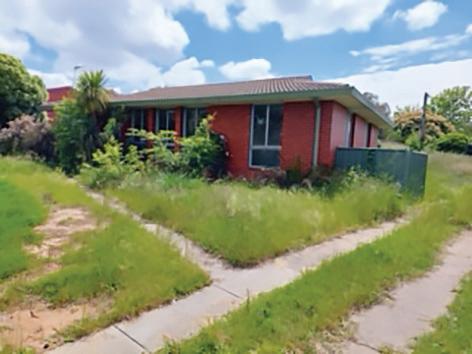
“As far as anyone knew it was going to be sold at some stage as it was still owned by Housing ACT.

“The house did not look too bad so I en tered the yard to have a closer look. As you can see from the attached photo, the house is basically in good condition, with no cracks in the brickwork, the roof and guttering in good condition and the windows all okay.
“We read about the shortage of housing in the ACT and just accept the fact, however when you actually see a property that could be economically brought back to life again for a needy family with kids, it makes you mad.”

The house is at 6 Bennett Place if anyone cares to look at it. Make yourself at home, the back door’s open.
Ian Meikle is the editor of “CityNews” and can be heard with Rod Henshaw on the “CityNews Sunday Roast” news and interview program, 2CC, 9am-noon. There are more of his columns on citynews.com.au
Narra beats Yarra to the red bows










SPEEDSTERS caught breaking the law would have their licence taken away and their cars impounded if the Australian Federal Police Association (AFPA) has its way.
The association’s president Alex Caruana is recommending officers be given the power to strip drivers of their licences on the spot if they are caught speeding on Canberra roads.
“That power already exists for hoons but not for someone caught speeding or racing with intent,” said Caruana, 40.
“Currently, if someone is caught speeding say 50 kilometres per hour over the limit they get a ticket, drive off, and 10 minutes later they are going to be speeding again.
“Being able to take that licence and car away from them means you immediately eliminate the risk to the Canberra community.”
Stronger police powers targeting speeding was one of a number of issues that the AFPA would like to see adopted.
Caruana, who represents some 4000 AFP members, has also questioned whether current sentencing in the ACT acted as a sufficient deterrent to
times drink driving, and speeding should not have a licence, but because that person is out and not in jail serv ing time they go and steal another car and get behind the wheel,” he said.
“Because a lot of people are being given intensive corrections orders, behaviour bonds or are out on bail, the message that’s being sent to the crimi nals is ‘you’ll get to see your family tomorrow’.”



He was also critical of the ACT gov ernment’s recent decision to decrimi
country.
“What it has essentially done is said to the crooks and organised crime ‘come to Canberra, we will roll out the red carpet for you, come and have your parties and sell these drugs’,” he said.
Other potential reforms that might impact adversely on the association and its members, included the suggested re moval of spit hoods – a mesh bag placed over the head of a detainee to stop them from biting or spitting – championed by Greens MLA Andrew Braddock.
“No one in the ACT has ever died be cause of a spit hood… to me it seems as if it’s all about political point scoring,” said Caruana.
“They [politicians] have never strapped on a pair of boots, put on a belt and gone out there and dealt with the dangerous part of the community.”
Although not a police officer him self, the Canberra born-and-raised Caruana, is an expert in forensic bal listics and has worked with the AFP since 2006.

Elected as president last year, Caru ana said he felt a constant pressure to look after AFPA members.
“I beat myself up a bit sometimes be cause I feel as though I have 4000 mem bers that I have to do the right thing for… it certainly stretches me,” he said.
Caruana had visited many crime scenes in his time in forensic ballistics and was all too familiar with the con fronting scenes faced by police follow ing shootings.
“You see, smell, do and experience things that no other human should or does experience,” he said.

Learning to cope and deal with those experiences was one of the chal lenges of the job, Caruana said.

That’s why the AFPA was calling for “presumptive mental health legis lation”, which excused officers from reliving those events in order to receive the compensation they were entitled to.
“With the presumptive legislation,
we are saying if someone has a tinge of an illness they can go in straight away and see a doctor, because the quicker they get help the more likely they are to recover and become a fully functional member of the AFP again.”
Caruana has his own unique way to take his mind off the stress of the job, he catches snakes in his spare time.

“If you are thinking about work while you are trying to catch the world’s second deadliest snake you are going to get bitten, so it forces you to not think about some of the things you have seen or smelt or experienced,” he said.
In an interesting career to date, perhaps the highlight for Caruana was being awarded the Timor-Leste Soli darity Medal and a Presidential com mendation for conducting the forensic ballistic investigation on the assassina tion attempts on the then East Timor ese president and prime minister Jose Ramos Horta and Xanana Gusmão.
“I was the only forensics person that was firearms ballistic trained there at the time… it was an eye-opening expe rience.”
Caruana rounds out his pitch by calling for greater resourcing for his members, pointing out they are the lowest paid and least resourced police force in the country.
“We have the lowest numbers of police officers in 2022 per capita than we did in 1970,” he said. “We need more police.”

LOOKING at the creative political sign in front of the Kingston Glass Workshop in October (now removed), the message was clear. We need to get our act together otherwise, just as with the koalas, we are stuffed.

This message is not new. Progres sive advocate writer Clive Hamilton has been on this case since the mid ‘90s. I bought his new book, “Provoca teur”. Five days later it was read.
This is an accessible account of his life as an advocate and writer and it is stacked with intriguing tales covering more than three decades, through the publishing of 34 books.
He tells how people and organisa tions reacted to what he wrote and, as a public advocate, spoke about what he wanted people to pay more attention to.
Conflicts and frustrations domi nated his two decades of seeking more climate action. Hence my connection to the koala and the message.
Clive wound down his climate advocacy in 2017, moving his focus to a political matter he considered was not getting serious attention – the influence of the Chinese Communist Party/ Government on sectors of Australian governments, business and society.
nearby would use their phones to hack into his.
It makes for a good read. Some very well-known names made it their business to attack him.
One astonishing story was about
known publishers also ran for cover until Hardie Grant happily took on the challenge. Freedom of the press Australian style won out – sort of.
The details around Clive’s efforts to have this book published will
make you think about how this could happen in this democratic country.
Having read “Provocateur”, Hamilton is definitely to be seen as a national treasure, as a voice, researcher and writer to be celebrated, recognised and honoured. However, there are a few points to be made. In 2009 he was unsuccessful as the Greens candidate for the federal seat of Higgins in Victoria. This was out of character for this advocate who generally avoids committees and political structures.
This incident plus a few com ments indicate a national alliance with the Greens. There’s also a hint of support for the ACT Greens.
The Australia Institute (which he set up, but is no longer directly involved with) has spoken publicly about the progressive politics of the ACT Greens. These are the same ACT Greens who are party to evicting Housing ACT tenants, signed off on the sale of multiple social-housing complexes to pay for the tram, have overseen the building of heat-island suburbs for the last decade and who look the other way while established suburbs are be ing de-greened and their biodiversity
diminished. This is an unfortunate soft spot in Hamilton’s ability to be objective.
Hamilton lives in Canberra and would be aware of the corrupted urban development and planning that is happening in his own backyard.
Homelessness and social-housing programs are a disgrace given the wealth of this country. Yet he chooses to not speak up about such things. Again, this is a reference also to the sign as artwork by Ian Hubbard above. We are stuffed!
Despite these criticisms, Hamilton has achieved a remarkable output of books and has initiated and partici pated in important national debates. I strongly recommend “Provocateur” as a gift for others or for yourself this Christmas.
More of Ian Hubbard’s art signs at contour556.com.au/artist/ian-hubbard/




Paul Costigan is a commentator on cultural and urban matters.
There are more of his columns at citynews.com.au

•
DES MOORE PrincipalThe KJB Law team has built a reputation in Canberra for sound legal advice, simplifying the complexity of the law by explaining it to you in plain English, and then working towards the best possible solution.
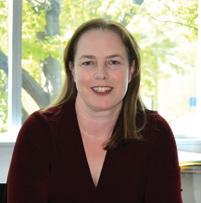


Our legal services include:
• Family Law
• Business and Corporate Law
• Estate Planning – Wills and Powers of Attorney
• Commercial & Residential Conveyancing
• Estate Management
•
•
•
•
•
LOCATED in its lush oasis boutique retail store in Pialligo, Living Simply offers full interior and exterior design services.
Owner, Graham Holbrook says that includes property styling, landscape consultation, design build and maintenance services.
Living Simply has evolved and expanded over the past 30 years from a commercial, indoor, plant-hire company to today’s comprehensive selection of indoor-outdoor decorator and feature plants, decor pots, water features and garden furniture.









Graham says he’s proud to have designers Robert Kimpton and Gary Ertl on his team, providing clients with their combined expertise of more than 60 years in landscap ing and interior design.
“In terms of the garden and landscaping, Living Simply is a one-stop shop. There’s not much we can’t handle,” says Robert, who is in charge of design, maintenance and horticultural consulting.
Having studied horticulture at Melbourne University, Robert says he has designed and built more than 75 gardens in Victoria, before relocating to Canberra in 2020.
“I offer landscape design as well as a consulting service in which I can come out to people’s gardens and answer questions and help solve the issues they might be facing in their gardens,” he says.
“Some of these issues might be drainage or choosing the right plants for a hedge. I provide a comprehensive report to the client,” he says.
Robert says that aside from the lifestyle benefits of enjoying a beautiful garden, there are tangible financial benefits, too.
“Studies have been undertaken that show
property value. So it’s important for my work to secure people’s investment,” he says.
Interior and exterior designer Gary Ertl moved to Canberra this year, and brings a wealth of experience from Sydney, Brisbane, Melbourne and London.
Gary says that his professional focus at Living Simply is on the interiors, either at home or the office, including plant hire as well as smaller and more intimate spaces such as balconies and courtyards.
“A lot of my role is the problem-solving aspect of the space. I’m always looking at how I can evolve a space into something beautiful,” he says.
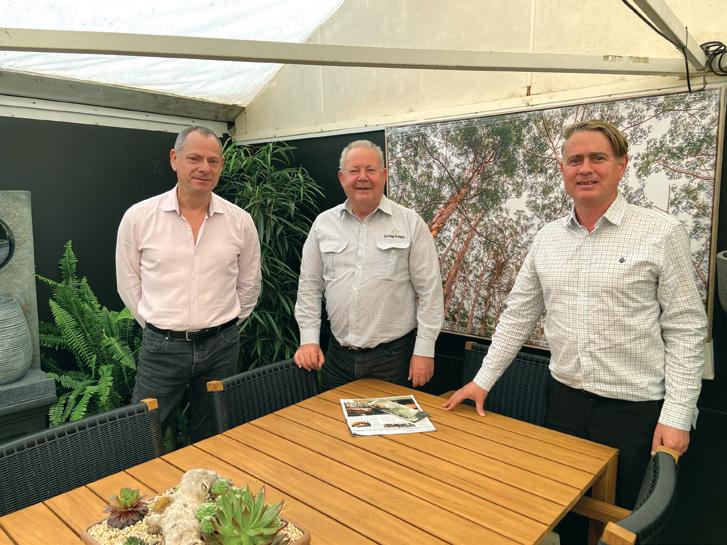
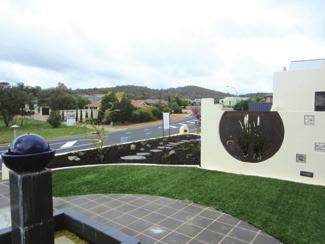
“Even in the cold Canberra winter, we greatly value the outdoor space and we need to see the outdoors as important in a home as
his ethos is to stay within the client’s budget and to design efficiently. He says he loves working with his clients to create their vision.
“My job is to get the client’s vision on track,” says Gary.
Graham says that at the heart of everything he and the team offer at Living Simply is the appreciation and respect for “biophilia”, which is defined as an emotional and physical connection between humans and nature.
“Combining state-of-the-art interior design, landscape design and advanced horticulture practices, Living Simply meets the biophilic needs that are essential to human wellbeing and connection,” says Graham.
Living Simply, 10 Beltana Road, Pialligo. Call 6249 1552 or visit livingsimply.com.au
‘In terms of the garden and landscaping, there’s not much we can’t handle’From left, interior designer Gary Ertl, owner Graham Holbrook and landscape designer Robert Kimpton. Interior design. Balcony & courtyard design. Landscape design, build & maintain.
ideological commitment to high-rise development and life in a flat.

HOUSING affordability has been a central element of the discussion generated by rising inflation and increasing interest rates.

However, declining affordability is not a recent phenomenon. It has been building up over a long period.
In its recent Budget, the Common wealth Government made a major commitment to improve housing affordability – the first significant policy statement on housing from a federal government in decades.
In this and subsequent articles, we aim to identify the factors driving unaffordability and assess the feasibility of the policy targets in the Federal Budget.
Successive increases in the official cash rate, promptly passed on by the banks, over the past several months have added an average of about $1350 to monthly mortgage costs. For many households, particularly those who entered the housing market recently, the monthly increase in mortgage costs is much higher.
Market research indicates that more than half (53 per cent) of mortgage holders will be in financial stress once the cash rate reaches 3 per cent, ie, with just one further increase of 0.25 per cent.
The interest-rate hikes are, of course, designed to combat infla tion. The rise in inflation has been largely driven by external factors, such as the war in Ukraine and the consequent increase in energy prices, and disruptions to supply chains. The relevant domestic factors include labour shortages, potential impacts of floods on agricultural production, and, most significantly, a failure to secure domestic gas production for domestic supply.


However, at least at a macro level, the policy does make sense, ie, increase the cost of money, thereby reducing consumption and, in turn, put downward pressure on prices. Interestingly, mortgage costs are not included in the inflation figures.


In addition to mortgage hold ers, renters are also experiencing
basis of the financial stress being experienced by many ACT families relates more directly to the increas ing dearth, over the last decade, of affordable housing in Canberra. Unfortunately, the blame game has been a defining feature of public discourse on the causes of the increasing unaffordability of houses; eg, the federal government is blamed for not investing in public housing; RBA for low interest rates; Australian Prudential Regulatory Authority (APRA) for its lax macro prudential supervision; banks for their lending practices; and even households for wanting to enter the housing market. Here in the ACT, households (in the main families) are, in effect, being shamed for daring to want to live in a standalone dwelling rather than to conform with the ACT government’s
In what can be described as a re markable distortion of basic concepts of demand and supply, the Housing Minister Yvette Berry and the Chief Minister and Treasurer Andrew Barr have claimed that the extraordinary increase in land and house prices in Canberra are not due to a lack of supply, and that the ACT government had been meeting demand.
Such claims are clearly nonsense and obviously do nothing to solve the problem of housing supply and affordability and in truth are little more than political spin designed to deflect responsibility for the chronic undersupply of land and detached housing over the past decade.
Put simply, many households bor rowed too much to buy a dwelling that cost too much in order to scamper into home ownership at a time the prospects of doing so seemed to be receding at an ever-increasing pace.
The fact is there were not and are still not nearly enough suitable dwell ings or available land to meet the needs and housing choice of Canberra households, most notably in specific sub-markets of the housing market, especially the market for detached housing.
In this context, the commitment by the federal government to build “one million new, well-located homes” over

five years from 2024 is encouraging. What is even more pleasing is the statement by the Treasurer, Dr Jim Chalmers that “it’s more important than ever that we work together to ensure there is an adequate supply of affordable housing where it is needed – close to jobs, transport and other services”.
For its part, the Commonwealth Government has committed to the supply of 10,000 affordable dwellings through initial availability payments of $350 million over five years. Beyond that period, incentive payments of $70 million a year for the next 25 years will be funded by the National Hous ing Infrastructure Facility. Under the Accord, states and territories will free up land, and make in-kind or financial contributions to deliver a further 10,000 homes over five years.

It is important to note and ap plaud the fact that, finally, there is an acknowledgment, albeit by the Commonwealth Treasurer and, by extension, the Minister for Finance no less, that the problem at the heart of the housing affordability crisis in Canberra and across Australia is a lack of supply, which is “affordable and where it’s needed”. That must be a good start.
Jon Stanhope is a former chief minister of the ACT and Dr Khalid Ahmed a former senior ACT Treasury official.
Canberra families are being shamed for daring to want to live in a standalone dwelling rather than to conform with the ACT government’s ideological commitment to high-rise development and life in a flat.” JON STANHOPE and KHALID AHMED take a deep dive into affordable housing…
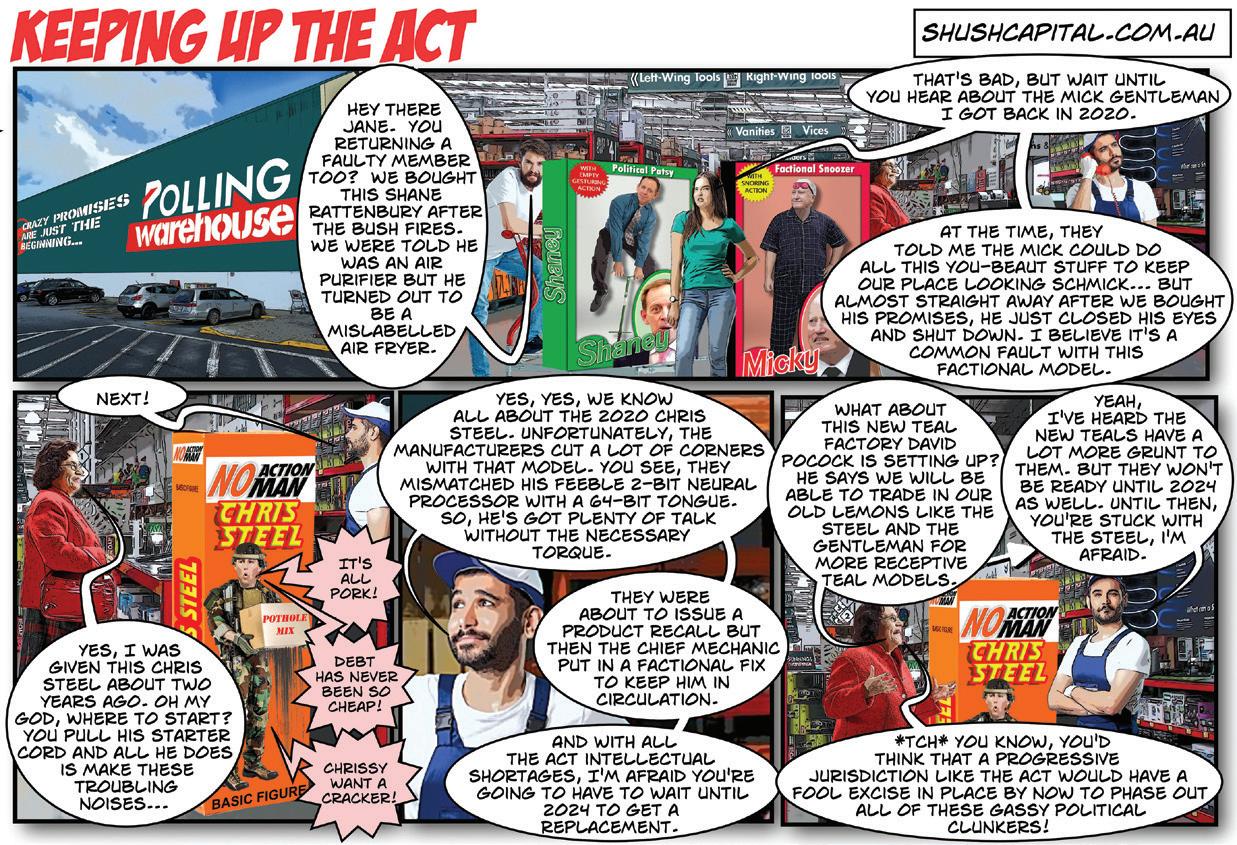

MOBILE phone detection cameras will be installed on ACT’s roads next year in a bid to reduce driver distraction.

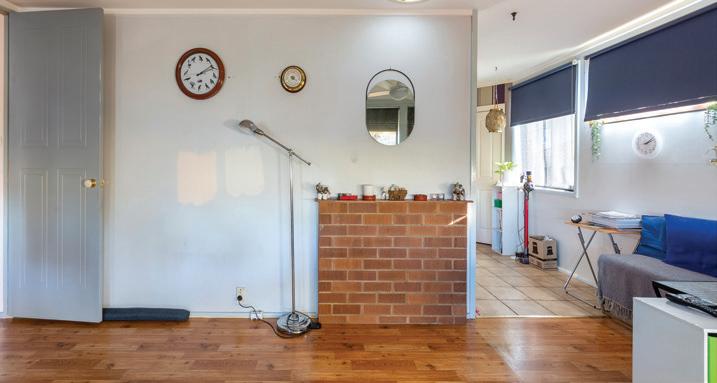
Two fixed cameras will be located on Hindmarsh Drive and Gungahlin Drive, and three transportable cameras will be moved across various sites in Canberra in cluding Canberra Avenue, Tuggeranong Parkway and Yamba Drive.
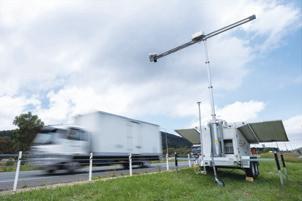
Transport Minister Chris Steel said police have issued an average of 911 infringements and 260 cautions for mobile phone usage while driving over the past five years.
“The actual rate of offending is likely to be much higher,” said Steel.
“A driver who looks at their phone for just two seconds while driving at 60km/h travels 33 metres blind.
“These new cameras, which will operate day and night in all weather conditions, will help ensure Canberrans understand that any time you take your eyes off the road to use your mobile phone while driving, you’re risking your own life and the lives of other road users.”
IN a normal eye test the most important parts of the process are the checks of ocular health, and these actually form the basis for the clinical recommendations for regular eye examinations.

In line with this there are very important symptoms that mean you should be seeing your optometrist. Some of these include: sudden changes in your vision, flashes of light, floating spots, sore eyes, itchy eyes, and red eyes.
Some of these symptoms can be associated with relatively minor conditions, but some can be associated with more significant health problems for your eyes.
All of them should be investigated by someone who is interested in the health of your eyes. Optometrists not only have the training for eye problems, but importantly have the right equipment to be able to assess your eyes properly and therefore start you on the right course of treatment.
In some cases, this right course of treatment might even involve sending you to your general practitioner for certain medications.
Some of those symptoms, particularly changes in vision, flashes of light and floating spots, have potentially serious consequences.
If you experience any of these symptoms, we recommend calling for an appointment as soon as possible. Normally, the testing for these symptoms is going to involve a thorough eye examination, so you would expect to have drops put in your eyes to make your pupils larger and enable this more thorough examination.
While in many cases this test shows nothing of great concern, the risk from the complications is why the drops are used, and why this test should be done as soon as possible after the symptoms are noticed.
At Collins and Lonergan we value your sight and your eye health. If you are experiencing any of the symptoms mentioned, or anything else that is causing you concern with your eyes, call us to discuss an appointment. We might ask you questions about your symptoms, but these are only to help us work out how soon we should be seeing you.
Collins and Lonergan Evolve Optometry is an independently owned optometrist in the centre of Gungahlin, located opposite Coles inside Gungahlin Village. Call 6189 5891 or visit evolveoptometry.com.au to book an appointment.

CHILDREN have been getting a raw deal from the ACT government regarding health.
There was a scathing report on the state of pediatric care in the ACT as per this column in “CityNews” in early November. Attempts are being made to improve hospital and other pediatric treatment systems.
Now the government has recognised that prevention is better than cure and announced efforts to improve the health of our children, especially in their first one thousand days.
Just $2 million was committed at the launch of “Best Start for Canberra’s Children: The First 1000 Days Strategy”. It is exciting that the government is taking steps at prevention in the early stages of life, hoping for less demand on our hospital and primary healthcare services.
The principle is right. However, much of the strategy is motherhood and, in the sense of broad generalisations, it is not enough.
The strategy says: “Evidence shows there are a range of supports and opportunities for engaging with children, parents and caregivers in the early years that can make a significant difference to a child’s life experiences, health, wellbeing and development”.
“These supports and opportunities are preventive and time critical, therefore we must invest early in life to have the most impact”.
Some of us remember the network of baby health centres that offered these services when my own children were in their first one thousand days. Budget cuts! This strategy feels so much like reinventing the wheel. Support for parents and their children was found in almost all Canberra suburbs at the time. Advice and connection were key elements of these baby health centres.
Parents of the time could learn about nutrition and breastfeeding, there was also weight and other health indications being monitored along with appropri ate vaccinations. All this by qualified nursing staff. Now it’s time to go back to the future.

Health Minister, Rachel Stephen-
Smith, in launching the “Best Start Strategy” argued: “A nutritious diet and being active both support healthy weight and contribute to good health. We want our children and young people to live well, and we know that healthy weight in childhood reduces the risk of developing chronic disease later in life”.



The minister also identified the im portance of physical exercise: “Optimum nutrition and physical activity during the early years of life are essential for normal growth, including both physical and cognitive development. They also establish healthy habits that can be carried into adulthood.”

According to the “Best Start Strategy” the evidence for a healthy start falls into six categories:
1. Providing better access to advice, support and services when needed.
2. Creating spaces for happy childhoods.
3. Focusing on good maternal health and family wellbeing during pregnancy.
4. Offering safe and connected communities.
5. Increasing resilience and protective factors.
6. Encouraging strong parent and caregiver child attachment and bonding.
Brief details are provided on how to achieve each of these. However, the lion’s share of implementation responsibility falls on an underfunded community sector.
The efforts of the non-government services in offering advice and provid ing such a range of services are really admirable. However, a measly $2 million in additional support across the sector is simply miserable.
No doubt there was considerable expense involved in funding the network of child health centres that supported families in the past. However, those centres played a key role in keeping children out of hospital.
Current support services offered by organisations such as Tresillian, Marymead and the Perinatal Wellbeing Centre are admirable. This is likely why the minister launched the “Best Start Strategy” at their First One Thousand Days Conference a few weeks ago.
In a smoke-and-mirrors approach, not all of the $2 million is specifically dedicated to the first one thousand days.

Of the money identified, there are “grants of up to $40,000 for commu nity organisations to deliver innovative activities that support re-connection within priority population groups. The targeted funding will aim to support priority populations in all age groups to re-establish social connection after the impacts of COVID-19 over the past two and a half years”.

To be really successful, the services identified in the “Best Start Strategy” are going to need considerable additional funding in the coming Budgets.
Michael Moore is a former member of the ACT Legislative Assembly and an independent minister for health. He has been a political columnist with “CityNews” since 2006.
ManagerDamien Lonergan Optometrist
ActewAGL Retail has been independently certified as carbonneutral through Climate Active for the second year running – both for ActewAGL operations, as well as its carbon-neutral gas product.
Climate Active is an initiative between the federal government and Australian businesses that voluntarily support climate action.
Climate Active certification verifies businesses that have credibly achieved net zero emissions.
Organisations must show rigorous adherence to standards to become certified.
Certification enables consumers to easily identify carbon-neutral businesses and products, so they can choose brands making a difference by reducing their environmental impact.
ActewAGL Retail’s general manager Rachael Turner says: “We are thrilled to have again been certified as carbon-neutral by Climate Active.
“Customers who choose ActewAGL will know they’re making a great choice and help ing with collective action on climate change.
“Achieving this position of net zero emissions is another significant way we are
demonstrating our commitment, in practical terms, to a more sustainable future – for our people, customers and the broader community.”

To further reflect its strong position on sustainability, ActewAGL recently launched a “Sustainability Promise”, which includes a commitment to maintaining Climate Active Certification, helping one in four ACT households drive an EV by 2030, and helping 30 per cent of ACT homes to be powered by solar by 2025.

“As the leading energy retailer in the region, we recognise the responsibility we have to provide products and services that help reduce environmental impacts and meet the evolving needs of our community,” Rachael says.
“Through our partnership with SolarHub and the new Smart Energy Hub in Mitchell, we now offer a range of solutions to help customers sustainably power their homes, businesses, and cars.
“We’ve also launched our online evHub, helping customers drive an electric vehicle sooner – with products and services to find, finance and charge electric vehicles.
“This expanded range of sustainable prod ucts and services, alongside the renewable and carbon-neutral options we offer on our energy products, are just the beginning.”
actewagl.com.au
Bringing good energy by ensuring our carbon emissions are equal to net zero.
‘The renewable and carbon-neutral options we offer on our energy products are just the beginning’The Molonglo River wends its way through Fyshwick.
A TEENAGE friend of mine, George, used a razor blade and fountain-pen ink to tattoo his girlfriend’s name on his lower leg, but she eventually ended up living with a local crim who threatened to take George’s leg off if he didn’t remove the tattoo.

George took the safe option and, like me, joined the Army.
When I was in my 20s, tattoos tended to be class-associated. In the Army some soldiers and NCOs had tattoos, but commissioned officers didn’t. If you saw an officer with a tattoo, it was because he was a “knife and forker” (an officer who had worked his way up from the ranks). I don’t recall ever seeing a female soldier with a tattoo.
Some tattoos have always been specific to a social environment. For example, prison tattoos are used to show gang membership, offences com mitted, time served, and may have other hidden meanings, depending on the country.
In the UK, four dots tattooed across the knuckles are substitutes for ACAB (All Cops Are Bastards).
Today it’s not uncommon for anyone to have a tattoo, often emulat ing movie stars such as Brad Pitt and Angelina Jolie, or sports identities
such as footballer David Beckham or boxer Mike Tyson. While tattoos are now widely accepted, neck, head and hand tattoos are probably guaranteed to limit one’s employment options.
What then classes as a tattoo?
Tattoos are a form of body modifi cation made by inserting tattoo ink, dyes, and/or pigments, either indel ible or temporary, into the dermis layer of the skin to form a design. Tattoo artists create these designs using several tattooing processes and techniques, including hand-tapping
traditional tattoos and using tattoo machines.


Most colour options are available, but black remains the safest option. Blue and green inks with copper phthalocyanine pigments are safe, too. Other colours may contain toxic chemicals and mercury. The reds are perhaps the worst choice because they can contain toxic iron oxide and cadmium.
It’s likely that, over time, many people who have tattoos will regret having them for various reasons –


darker-coloured inks can be removed completely, while lighter colours, such as yellows and greens, are very difficult to remove.
fashions change, tattoos fade with age, health concerns, falling out of love etcetera.
How hard is it to remove them?
Today it’s often possible to remove tattoos, fully or partially, with laser treatments. Carbon-based pigments, or iron-oxide-based pigments can be removed more completely than inks of other colours.
Laser tattoo removal is said to be more painful than getting the tattoo. The standard modern method is the non-invasive removal of tattoo pigment using Q-switched lasers.

A Q-switched laser is a versatile laser that offers different wavelengths to target a variety of skin conditions.

Different types of Q-switched lasers are used to target different colours of tattoo ink. Typically, black and other
There are a number of factors that determine how many treatments will be needed and the level of success one might expect. These include the age of the tattoo, size of tattoo, ink density, ink colour, skin colour, location, and depth at which the ink was applied – and whether it was done profession ally or not.
If you plan to get a tattoo, be very clear with your instructions to the tattooist. Wayne went to get a tattoo on his back and asked the tattoo artist to do a red Indian. Halfway through Wayne said: “Don’t forget to put a big tomahawk in his hand.”
The tattooist said: “Hang on, mate, I’ve only just finished doing his turban.”
Clive Williams is a Canberra columnist.
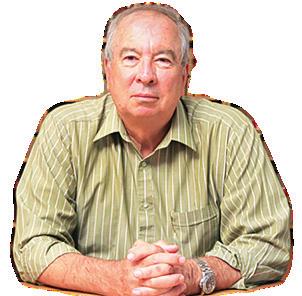
It’s likely that, over time, many people who have tattoos will regret having them for various reasons –fashions change, tattoos fade with age, health concerns, falling out of love etcetera.A tattoo artist adorns a client’s arm.






It is well-known and reported that Australians underestimate how long they will live by about five years.
More concerning, Australians underestimate the costs of living as they age, generally forgetting about needing extra supportive care in the home or in aged care.
For people over age 65 today and a member of a couple, your life expectancy is approximately 93 years. Having a plan to 'outlive your money' and giving you enough retirement savings or investments is critical.
Have you planned for your frailty years?

The concept of running out of funds between your retirement to the end of life is a pretty grim thought but worthy of serious attention while you are young enough to do something about it.
Planning for your frailty years, (e.g living with more than one comorbidity) warrants careful thought about whether your savings will last the distance.
What to do?
Work out how much you think you will spend each year for 25+ years after full-time work stops. Consider how will you pay for extra care if your or your partner’s health fails.
If you need help, an adviser will calculate the amount of superannuation you will likely need for your retirement –based on your short, medium and long-term goals – and they will help tailor a personalised strategy for growing your nest egg while you’re still working.
There are sensible, simple and widely used solutions to help support other income sources that can improve or enable eligibility for some age pension without the worry about share market volatility.
To learn more, call us on 1300 10 22 33 or book a 15 minute call (at no cost) via our website phillipswp.com.au

HERE’S a song every reader has heard. The lyrics that we all know well include:
What have I got to do to make you love me?
What have I got to do to make you care?
What do I do when lightning strikes me?
And I wake to find that you’re not there?
What do I do to make you want me?
What have I got to do to be heard?
What do I say when it’s all over?
And sorry seems to be the hardest word.
It’s sad, so sad. It’s a sad, sad situation.
And it’s getting more and more absurd.
It’s sad, so sad. Why can’t we talk it over?
In his song Elton John has grasped being sorry in our world, grasped and explored how elusive it is.

Take a moment now to select your preferred version of this song from the links below. Play while you read.
You can see and hear the great man on a big piano at youtube.com/ watch?v=c3nScN89Klo
There’s an edgier version by Joe Cocker, with Deric Dyer on sax, at youtube.com/watch?v=axcXYkiO82Q and for a duet for the ages, take Elton and KD Lang together at youtube.com/ watch?v=P0SVR3kyrdE
Too many lawyers in insurance and injury work have confused “being sorry” with taking the blame, as it being an admission of being the cause of someone else’s distress. It isn’t.
Sometimes the “sorry” expressed by of fenders in our criminal justice system is dismissed by sentencing judges as being nothing more than, “I’m sorry…that I was caught”. That’s a self-pitying sorry. It is better left unsaid.
Usually, though, the bare “sorry” is an explicit recognition that someone else has been harmed, inconvenienced, is experiencing physical or mental distress. The “recognition” encompassed in “I am sorry” is a kindness and a validation to the recipient. Elton is expressing a sorry that is beyond that.
The next step in the hierarchy of “sorry” is that some legal matters can be solved, or rather reduced in scale, if there is an apology. This requires acceptance of responsibility for the injury done to the recipient.
An apology may be made to an individual or a group.
The individual apology can be seen when the writer or utterer of defamatory remarks can contain the monetary pay
out by a carefully framed, well-delivered apology. It can also be seen in Circle Sentencing, which is an alternative path way, outside of traditional “punishment” options, for not too serious criminal offences. The offender offers an apology, which the victim agrees to accept.

The group apology is seen in Prime Minister Rudd’s apology to the stolen generations in February, 2008. He began: “We apologise for the laws and policies of successive parliaments and governments that have inflicted profound grief, suffering and loss on these our fellow Australians…”
Beyond the apology are “contrition” and “remorse”. Sentencing judges and magistrates are hoping to see signs of this level of personal acceptance of responsibility, both for what the offender did, and the consequences of that act or actions. There must be an expression by the offender of a “deep regret”.
Without such self-awareness and a capacity to feel the harm done to the victim, the notion of “rehabilitation” is empty, because to rehabilitate is to make good, to restore, to give value – none of which are possible if the offender lacks the motivation to make any changes to their approach to life and community.
But as Elton’s lyrics show, the causes of grief, the scope of regret, and the place for sorry, can be complex, even maze-like, so that the path to follow to a better future is far from clear. “Sorry” comes with so much baggage that its unpicking is difficult, but we must search for it in our criminal justice system.
We won’t always find it; for example, an innocent who is wrongly convicted
cannot apologise, cannot express contri tion or remorse.
Stop the music. Pick one of the other performances. You will notice that the same words carry distinctively different messages when borne by a different musi cal treatment and a different voice.
So now you understand how the same facts lead to different sentencing out comes because the attributes of offenders (singers) change, and the underlying atmosphere (the musical performance) also changes from one version to another.
What’s more, those who sentence offenders have innate preferences for one singing voice over another, for one instrument over another. Just as we do.
When Elton sang: “What have I got to do to be heard? What do I say when it’s all over?” he was asking the questions that every good courtroom advocate is asking every time they go into a court or tribunal. An answer in time is a win.
I can answer his closing refrain, “Why can’t we talk it over?”
The answer, my friends, is blow ing in the wind. It’s a question and answer to be repeated every day, with or without Bob Dylan (youtube.com/ watch?v=MMFj8uDubsE).
How about listening again? You’ll be so glad you did.
Hugh Selby is a recently retired barrister who enjoyed appearing in criminal jury trials and teach ing about them.


“CityNews”, Canberra’s premium weekly news magazine and daily website, is looking for an experienced, full-time, professional journalist who can write evocative news, write beautiful features, write for a hungry website and write for the love of it.
You’ll need a working knowledge of Canberra’s political system, its social history and its geography to get to first base. After that, you’re in the race.
We’re thinking of a late-January start, but let’s get talking and see what suits you.
Apply to our MD Kate Meikle via kate@citynews.com.au, but write now!
Sometimes the ‘sorry’ expressed by offenders is dismissed by sentencing judges as being nothing more than, ‘I’m sorry…that I was caught’. That’s a self-pitying sorry. It is better left unsaid.
Elton John... “It’s sad, so sad. Why can’t we talk it over?”
“EVERYBODY complains about the weather, but nobody does anything about it.” So said Charles Dudley Warner in a quote commonly misattributed to his good friend Mark Twain.
The same goes for “politics makes strange bedfellows”. Oddly enough, these two little quips, taken together, will decide the future of humanity.
It is now clear that the scientists of the Intergovernmental Panel on Climate Change were too sanguine in their predictions of the chaos that even the 1.5-degree increase in global heating would wreak upon the species that caused it.
They either underestimated the effect of the feedback loop that increases the problem exponentially, or they merely provided advice instead of rousing the populace to action. Scientific politesse trumped bellowing rage.
Moreover, they failed to join the dots where the rolling pandemics, economic disruption and rising nationalistic hysteria, would all follow the collapse of manageable weather systems.
That, alas, is what is now staring us all in the face. The Arctic ice is melting at an increasing rate, the methane is rising from the great Russian tundra, the melting snow and ice from the Himalayas to the Antarctic are not just raising sea levels, they are rearranging the oceanic currents and winds that result in wild inundations like the ones we’re suffering right across eastern Australia.

And this is just the beginning.
Our feeble international response is so pathetic that it’s reflected in the first of Mr Warner’s quips. The second is a work in progress.
The four great polities that have within their power to act in concert to at least slow the feedback to manageable proportions –America, China, Russia and India – are led by men so wrapped in their own political survival that they’d rather blow up the bedroom than hop between the sheets.
Even Joe Biden’s America, which used to accommodate both sides of the political spectrum in an admittedly spacious double bed, has split into two singles – one red, one blue – and never the twain shall meet.
So, where do we go from here?
Curiously, I think the answer lies in the very extremity of the climate changes that are bedevilling the world and threaten to become existential.
We have seen the response in miniature time and again as the fires bear down on townships or the floodwaters rise to unimagined heights. When that happens, communities transform themselves to become mutually supportive entities. Where once they were niggling neighbours, now
they’re roaming Samaritans willing to put their own lives in danger to rescue the very bloke they used to feud with.
And at the official level, local, state and federal authorities put aside their differences for the common good. The day is coming when, together, they will recognise that SES volunteers can no longer handle the crisis; a new professional organisation of civilian emergency workers will be created to deal with the disasters. And our economies will be reorganised to incorporate the Disaster Force into a major industry.
Next step is the realisation that we might not be in bed together, but we’re all in the same boat; and the disaster industry will be upscaled to an international force whose operations will ignore the man-made borders that used to mean so much.
At such a time, the pretensions of small men such as Putin, Trump, Modi, the mad mullahs of Iran et al will seem simply pathetic as they’re washed away in a flood of human sensibility.
Well, that’s my dream anyway.



robert@ robertmacklin. com
PLANS to include a community-scale battery in the newest stage of development in the suburb of Jacka, in north Gungahlin, are underway.
A two-stage tender process has opened seeking expression-of-interest applications from providers to deliver the battery project, which would allow residents to access stored energy generated from renewable sources.
Jacka’s newest development will feature 700 single residential and multi-unit homes, with the ACT government claiming the communityscale battery would make Jacka Australia’s “most sustainable suburb”.
RESTORATION of the Canberra Croquet Club’s clubhouse, pictured, in Yarralumla, which includes new toilets and kitchen, upgrades to the storage room, the installation of a ramp and the removal of asbestos, is complete.

The clubhouse was built next to the Hyatt Hotel in 1933, and is heritage listed.
The renovation work was made possible through a $410,000 grant from the ACT government, with the club adding $100,000 of its own funds.
DO I detect a whiff of Greens’ sanctimony in Peter Lyons’ comments on my letter (CN October 27) about Australia’s greenhouse gas emissions?
It is true that the majority of countries have emissions less than Australia, including France and the UK, both of which have significant nuclear and hydro sources. In fact, Australia is about 15th on the ladder.
It is a fruitless task to compare whether emissions by countries are equitable or not, given vast differences in population, industrialisation, natural resources mix and topography (a big factor for Australia).
The point of my letter was that, at about 1.2 per cent of world emissions, no matter what Australia does and spends on renewa bles in the hope of reducing its emissions, it will have zero effect on global warming let alone climate change.
Our priority is to climate-proof Australia, not waste billions on wind and solar renewables and hugely expensive and invasive infrastruc ture (poles and wires) for zero return.
On the question of nuclear energy, China may be developing its solar and wind energy generating capacity at a fast rate but is also developing 150 nuclear power stations (as well as fossil fuel-powered plants), in recog nition that renewables will never be able to meet its ultimate demand for electricity.
France and the UK have operated nuclear plants for decades without incident.
The greatest hurdle to nuclear energy
in Australia is the absurd policy of having banned it, yet we are hypocritically happy to export our uranium.
Finally, the argument that Mr Lyons makes that Australia must get its 1.2 per cent emis sions down because so many countries have fewer emissions (they all add up to some 25 per cent), is pure Greens’ sophistry. And his argument about my contribution to income tax, which I am happy to pay, as I have done all my life, is pure crooked thinking (argument by imperfect analogy).
Max Flint, Erindale CentreCHINA may well be developing solar and wind faster than nuclear power as asserted by Dr Mackenzie (Letters, CN November 10).
However, it also has big plans for nuclear (Letters, CN November 3), and why not given that it will provide firming power, which solar and wind are unable to do.
That aside, it is still building coal-fired power stations at quite a rate as well.
Chris Rule, ConderVI Evans (Letters, CN November 17) is wrong again. Hydrogen is not at the “experimental” stage: it’s been used as a fuel, either in fuel cells, or – less commonly – in tanks for years.
In January, Fortescue Metals purchased, to replace almost half of its Pilbara iron-ore mine haul trucks, battery and hydrogenpowered trucks. There are now also at least three hydrogen fuel-cell vehicles, from Honda, Hyundai and Toyota, in production and on the market.
Hydrogen is not “very expensive to produce” if solar energy is used as, for example, by Fortescue. It is not very difficult to transport if double-layered, vacuuminsulated tanks are used.
And hydrogen is not “explosive” unless, as was the case with the Hindenburg airship disaster, ignited by a careless flame.
Dr Douglas Mackenzie, Deakin
AUSTRALIA is ideal for small, modular nuclear reactors distributing energy. We have the uranium and ideal storage on a geologically stable plate, ready to be reused, when future technologies unlock its potential.
Those inefficient Chinese solar panels (check your warranty) have a two to threeyear footprint and are losing efficiency fast, with no government policy on disposal of this toxic waste.
The renewable dream is a disaster in progress for Australia, which can be averted but only if we let our engineers lead with logic and facts, rather than our idealogue pollies and conflicted scientists.
Ken Murtagh, HughesBUMPING up dwelling EERs by a notch is a relatively easy task for state and terri tory ministers, and no doubt can be very beneficial for individual occupants of new homes if the higher standards are consist ently monitored and enforced.
However, EER box ticking does not ad dress the wider public costs of having larger homes on smaller blocks, siting towering high-rises with small and generally hardsurfaced surrounding footprints, having fewer trees able to shade private land and large, hard heat-retaining vertical walls and ground-level surfaces, allowing swathes of new suburbia to still face east-west, approv ing the use of dark roofing and having too few and also poorly-sited street and other public-space trees with wide canopies.
Our ministers and planning authorities cannot afford to turn a blind eye to the need for all urban densification areas to at least include bigger setbacks, and substantial additional and adjacent open, green and well-treed spaces for the use, comfort and well-being of not only thousands of new residents but also the greater number already living nearby.
The tunnel-visioned, yet lucrative focus on cramming in more “residential, residential and residential” at the expense of anything else, means a poor start already on mitigat ing the urban heat generation and heat trapping that is occurring across these large precincts and beyond. It is hard to have faith
that many of the above contributing factors will be counteracted in timely and less piecemeal ways, not only by the still obtuse ACT planning reform package but also by the ACT government’s many existing plans and strategies that modestly aim to increase our urban forest, cool the city, ensure tree canopy for residential blocks and improve liveability and well-being in general.
The public deserves more honesty and transparency from ministers and local MLAs about progress made on addressing these physical liveability and amenity issues, well before the next election.
Sue Dyer, DownerI’M devastated! Peter Robinson (Letters, CN November 17) has nailed me to the floor with his assertions I’ve got the goals and motivations of the Voice all wrong.

Furthermore, I am nothing short of con descending in offering advice on the topic despite it being sourced from Constitutional experts, noted historians and, critically, highly respected national indigenous elders. I am also “strangely religious” it seems and have been blind to the “lashings of political spin” in the Voice proposal.
Oh well, I guess I’ll just try and console myself with Disraeli’s observation: “How much easier it is to be critical than to be correct”.
Eric Hunter, CookExperienced in all areas of Family Law, including adoptions.
Ken is an accredited business and family mediator.
First
I’m devastated, nailed to the floor!
COLUMNIST Ian Meikle (“Seven Days”) and correspondents in “CityNews” (November 10) outlined numerous issues with the light rail project.
The most alarming is the government’s inability to justify the project. It either gives the most superficial of answers or more commonly, silence. Its approach is the antithesis of transparent and accountable governance.
It has relied on the lack of engagement of many in the population with local issues despite the significant and increasing impact those issues have on well-being.
These impacts include the poor use of limited infrastructure funds, increased hos pital waiting times, increased congestion, the absence of convenient public transport, inadequate maintenance of roads, bridges, footpaths, open space and cycleways, the poor quality and design of housing redevelopments and the lack of appropri ate, affordable and secure housing.
These poor outcomes suggest the Liberal opposition, if it can persuade the electorate it has shaken off the Zed millstone, and quality independents could be in a position to challenge for government.
The government’s simplistic, ill-considered strategies (eg light rail good, other forms of transport bad; high levels of redevelopment good, adequate greenfields supply unneces sary) are a result of insufficient analysis.
To paraphrase George Bernard Shaw:
for every complex problem there is a simple solution – it is always wrong.
Its approach is indicative of a lazy and arrogant government largely unchallenged in its 22 years in power
The community deserves a government that bases policy on evidence not political expediency.
Mike Quirk, Garran
ACCORDING to a well-known expression, Rome’s emperor at the time, the decadent and unpopular Nero, “fiddled while Rome burned”. The expression has a double meaning: Not only did Nero play music while his people suffered, but he was an ineffectual leader in a time of crisis.
If you hang around long enough, history has a habit of repeating itself. In 2022 it could be said that our very own Nero (Andrew) oversaw this city’s decline by diverting precious scarce funds into a rattling tram instead of wider more pressing issues better benefiting his citizens and city.


HOW simple it is that guidelines for a literary award in Canberra can exclude a Canberra writer.
I am the author of “The Glass Cricket Ball”,
City News June 23). I have lived in Canberra for most of the last 55 years.
“The Glass Cricket Ball” was conceived many years ago when I was a voluntary guide at the AWM. It was written by me in Canberra during the last two years when I was a resident of the suburb of Bruce.
Okay, rules are rules. A few months ago I moved over the mountain to a retirement village at Tumbarumba and am therefore technically a NSW resident.
I am not an award seeker. I just hope “The Glass Cricket Ball” will be seen by readers as a very Canberra story, regardless of the rules.
Jan William Smith, Tumbarumba

REMEMBER Norm and Life. Be In It? ACT Walking for Pleasure is an initiative still going strong over three decades later. Why the longevity? It’s partly in the name. We were supposed to be an activ ity that was relaxing, refreshing and fun, to get older Australians, like Norm, off the couch. We still take the “pleasure” part of our mission seriously.

It’s also Canberra. Where else can you go for a bush walk or find 360 panoramic views, only kilometres from the CBD? It’s as if we were designed for this place, and this place was designed for us.
ACT Walking for Pleasure offers
design and lead walks, there is plenty of variety on offer. And you get to discover all sorts of hidden treasures in Canberra you didn’t know existed.
All walking abilities are catered for. About half our walks are two hours long, which is basically your 10,000 steps. But we have a one-hour Thursday stroll for those with limited mobility, all the way to longer, all-day walks twice a month.
Ken Finlay, president, ACT Walking for Pleasure (actwfp.org.au or email info@actwfp.org.au)
WHETHER it’s folk, ballroom, belly dancing, hip hop, contemporary or something else, Canberra has no shortage of talent when it comes to dancing. Besides the sheer fun of it, dancing can improve confidence, co-ordination and creativity, and is a great way for people of all ages to have fun, form friendships and get fit.
This week “CityNews” talks with some of Canberra’s movers and shakers who know how to teach their talent.
TEACHING a range of classic dance styles, Dale’s Ballroom
Dancing offers a fun way to get fit, socialise and compete in a friendly environment, says owner Dale Harris.
With medal classes on every Thursday from 5.30pm, Dale says she loves to welcome anyone to come and learn regard less of age or experience.
“We have people of all ages coming in for the classes,” she says.
“One of the great things about it is the fitness. You don’t realise how much exercise you’re doing, you’re constantly on the move.”
Dale is an expert in many styles of dance including New Vogue sequence dances, standard, tango, foxtrot, quickstep, Viennese waltz, and Latin cha cha, samba, jive, rumba and paso doble.
Backed by more than 25 years’ experience teaching dance, she started dancing at the age of six, when she developed an interest in ballroom dancing.

She’s since received many qualifications in ballroom dancing and is also a championship adjudicator who travels interstate to judge ballroom competitions.
Adult social classes are on every Wednesday from 7pm, and courses are run every seven weeks.
“Anyone can join. You can just rock up on the night and we can get you caught up in the course as we need,” she says.
Social dance is on every Monday from 7.30pm, “everyone and anyone is welcome”.
Dale’s Ballroom Dancing, 6/38 Reed Street North, Greenway. Call 0407 066110 or visit dalesballroomdancing.com

DANZON Dance Studio was opened in 2003 and will celebrate its 20th anniversary next year, says owner Marko Pekkarinen.



“We teach ballroom dancing, Latin American dance and swing,”
“The Strictly Ballroom movie sparked popularity in ballroom danc ing, and created a higher demand, and I just happened to be looking in the paper for what sort of job I might do over the summer holidays and I came across an ad for a ballroom dancing teacher.
“My mother dragged me to my first dance class because they needed more male partners, but I can say I went will ingly to the second class and all the classes after that.”
Marko says Danzon will be closed over the Christmas period, but will reopen for private classes on January 1, and term 1 of group classes will begin from January 30.
“We’ve been at our new location in Fyshwick for two years now, and expanded across two full-size ballrooms,” he says.
“We teach using a combination of private lessons and group lessons to personalise people’s learning.
“Our teachers are also specifically trained not only as good dancers, but to be good at teaching dance as well.”
Danzon Dance Studio, 96 Barrier Street, Fyshwick. Call 6257 5891 or visit danzon.com.au
“We’ve grown from offering just classical ballet and jazz, to include musical theatre, lyrical, tap, contem porary and specialised classes for preschool-aged children,” she says.
“At LCDC, we have a focus on classical ballet, as it is the foundation of most dance styles universally. I truly believe that dancers with classical ballet training stand out in a crowd as being well-trained in technique, posture, versatility and disciplined in their art form.
“The past few years have enabled us to grow, and we now focus on performing arts as a whole.”
With fantastic, qualified teachers across all styles of dance, Lisa says LCDC is committed to providing excellent dance education.
“We are very excited to be bringing in new programs

aged students. This program focuses on using imagination and storytelling to introduce our youngest dancers to the world of dance.
“This program, in addition to the Royal Academy of Dance syllabus, will provide students from ages three to 18 with beautifully structured, age-appropriate dance training.
With alumni from LCDC in companies such as The Australian Ballet, Birmingham Royal Ballet, Moulin Rouge, and graduating students going on to study dance professionally, “it’s clear that LCDC is indeed, one of Canberra’s leading dance schools.”
Lisa Clark Dance Centre, 3/73 Sheppard Street, Hume. Call 6260 2272, or visit lisaclarkdancecentre.com.au

• Once upon a Ballet classes for preschool ages.




• Junior dance classes include Ballet, Jazz and Musical Theatre.
• A wide range of classes for senior dances, starting from grade 3 all the way through to advanced classes in college.
HOME to more than 64,000 residents, Queanbeyan’s name is the anglicised form of “quinbean” – an Aboriginal word meaning “clear waters”.
It was officially proclaimed a township in 1838 when the population numbered about 50, but is now one of the fastest growing inland cities in NSW, according to the Queanbeyan-Palerang Regional Council.
“CityNews” speaks with experts in the Queanbeyan region who are passionate about what they do.
QUEANBEYAN Golf Club was formed in 1925 and will celebrate its centenary in a few years’ time, says general manager Glen Lloyd.
“It has grown from a nine-hole, sand-green course to the 18-hole championship layout available to members and visitors today,” he says.
“QGC hosted the 2019 NSW Women’s Open and has held the NSW Open Qualifying tournament for the past three years. The club has 700 golfing members and more than 2000 social members.
“The club offers quality golfing at an af fordable price, complemented by a renovated clubhouse comprising award-winning bistro, TAB, Keno and gaming facilities.”
Glen says a new outdoor area has been recently introduced, allowing patrons to enjoy the golf course outlook and the accompanying wildlife while enjoying a meal or beverage of choice.
“The club’s PGA golf professional Jake Nagle and his team of professional staff are available for lessons outdoors or in the team’s indoor golf simulator,” he says.
“The shop also contains the latest golf equipment for golf enthusiasts.
“Queanbeyan Golf Club proudly supports the Queanbeyan community and plays host to many corporate and charity golf days and functions.
“The club has a relaxed and friendly vibe. There are no strangers here, only friends you haven’t met yet.”
Whether it’s great golf, amazing food, an extensive drinks menu or entertainment options, Glen says Queanbeyan Golf Club has something for everyone.

Queanbeyan Golf Club, 5 Brown Street, Queanbeyan. Call 6297 1669, or visit queanbeyangolf.com.au
THE Q – the Queanbeyan Performing Arts Centre – hosts the best of theatre, comedy, music and dance from around the Queanbeyan region, says artistic director Jordan Best.







It engages with “all the joys of country town living with all the benefits of the city” by being within walking distance of restaurants, cafes and bars.
Bringing laughs and glorious entertainment for all ages, the carefully selected program ensures “there will be something for everyone at The Q”, Jordan says.

Queanbeyan businesses.
“The Q’s membership makes a fantastic Christmas gift and gift cards are also available at our box office that can be spent on any performance at our venues” Jordan says.
Jordan says “the end of the year is full of shows at The Q!”
God of Carnage, pictured below, from November 23 to November 26.
• A Salute to Roy Orbison on November 25.
The Australian Rugby Choir on November 26.
y sponsored by

family friendly events that foster a sense of community, says community events officer Sarah O’Malley.
Operating for just over eight years within both the Queanbeyan and Palerang regions, she highlights “the strong sense of community, camaraderie and friendly faces” walking down Crawford Street in Queanbeyan.
“QPRC offers all the services of a local government”.
The QPRC events team specifically manages events within the community including the annual Christmas Community Carols, Australia Day celebrations and Christmas in July as well as welcoming new citizens through their citizenship ceremonies.

The QPRC events team also aids groups and other event managers with events such as Anzac Day, Googfest and classic car shows, says Sarah.
them involved in our events, especially the upcoming Queanbeyan Street Christmas Party and Community Carols.
“Our Bungendore, Captains Flat and Braidwood com munities are awesome to work with and their events always have a great local feel. Seeing the local schools, volunteer groups like Lions, Rotary, CWA and SES get involved to ensure everyone has a fun time is always a highlight and makes all the hard work we put into the events worth it.
“We can’t wait to see these all come together for the Braidwood and Bungendore Community Christmas parties!”
QPRC. Visit qprc.nsw.gov.au/Community/Events

WITH more than 30 years’ experience in strata management, Bridge Strata’s NSW branch director, Jan Browne, is not only an expert on the region, but an active member of the community, too.

Jan manages clients in Queanbeyan, Yass, Bungendore and surrounding areas, and believes she now handles about 90 per cent of community strata in that region.
The team has moved premises to the corner of
recently recognised at the Strata Community Asso ciation’s awards night for professional commitment to service and ethics.
She’s also thankful for her professional team –comprising Amanda Dengate, Jenny Muller and Jess Hocking. Amanda has recently achieved her “class two” agent qualification and now manages her own portfolio of clients.
“Jenny and Jess are both undertaking their


FEDERAL Member for Eden-Monaro Kristy McBain says that despite going through tough times in recent years, in which the local community has been impacted greatly by fires, floods and border closures, the resilience and community spirit is still very much alive and well.

“It’s nice to see people shopping locally, sourcing local produce and the number of people coming into our region to spend their holidays is extremely promising,” says Kristy, who is also Minister for Regional Develop ment, Local Government and Territories.
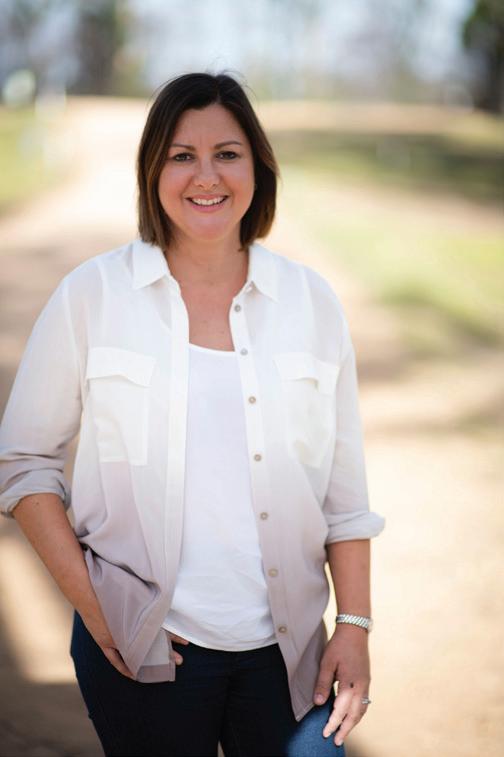
Kristy says that there is a definite sense of community that is unique to the towns and villages of the Eden Monaro region: “People often say to me how different Queanbeyan is to Canberra. There’s a totally different feel and it’s because Queanbeyan is a big country town.”
“I recently held a coffee catch-up at Bungendore. It was great to meet the locals and hear their queries. Kylie at the Junction Cafe had some questions that locals had left with her to pass on to me. It’s great that so many people want to engage with me, their local member, and share their opinions.”
One big issue facing Kristy’s electorate is the improve ments to internet and telecommunications connectivity.
“I made it my intent to better connect the community during the election, and I am pleased that we have been able to make the biggest investment in the NBN in the Budget,” she says.
“We all know that over the past couple of years, with working or learning from home, that connectivity is vital. That’s why I have prioritised this issue, in response to what people need.”
Get in touch with Kristy McBain on 6284 2442 or email kristy.mcbain.mp@aph.gov.au
MORASCHI Roofing is a family-owned business that’s been operating for 20 years, supplying and installing metal roofing, fascia and guttering and wall cladding to new residential and commercial buildings.
Owner Trudie Moraschi says that they have loyal staff that have been with her and her husband, Lee, since the beginning.
“We guarantee our workmanship and we are constantly training and educating our staff to ensure the best quality of work,” says Trudie.

Moraschi Roofing is seeking apprentices for
plumbers,” she says.
“We have successfully trained many apprentices, some who are now supervisors within our company and some who have started their own businesses.
“We have a young, knowledgeable crew who know how to engage and teach new people to the industry and we do lots of team-building activities and have good incentives.”
Trudie says that interested applicants can get in touch with her via email office@moraschiroofing. com.au.
TILE trends have turned to warmer colours and textures blended with classic chevron, herringbone and encaustic looks, says Rivoland Tiles general manager James Hibberson.






“Finishes often seen as traditional are making a comeback, with reinvigorated style and colour,” he says.
“Terrazzo and marble styles are available with so many great options and attributes that they can work with almost any space.”
With showrooms and trade stores in Quean beyan and Mitchell, the flagship store in central Queanbeyan sits across from a beautiful park, close to cafes, restaurants and shops, servicing people from regional NSW and the coast, James says.
He says Rivoland Tiles is a proud family-owned business, built on a strong ethic of customer service and product choice.
“We’re one of the largest stockists on the east coast importing unique and exclusive products from Italy, Spain and China, allowing our customers the best choice and competitive prices,” he says.
“If customers have found something they like online, ask us about it. We’re more than happy to help them source that perfect tile.
“Our customers are the reason we love what we do. Working on all aspects of tiling from repairing a sill tile to supplying developments, no two days are ever the same.
“Best of all, the people of Queanbeyan are great.”

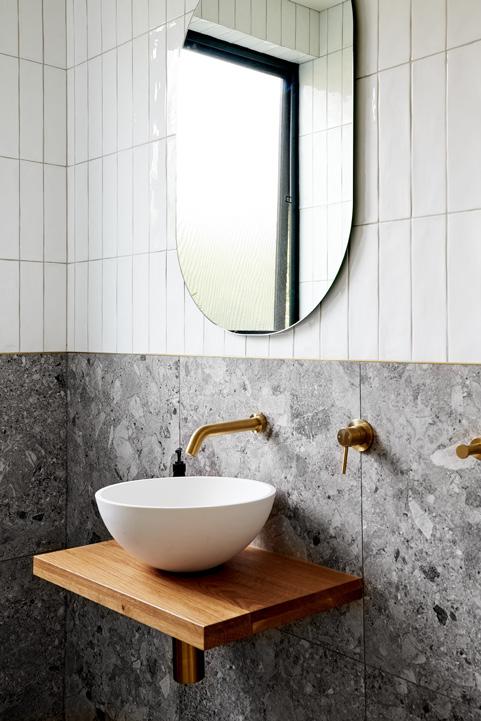
Rivoland Tiles, 100 Crawford Street. Call 6297 4510 or visit rivoland.com.au
•
•
•
•
•

•
•
Mitchell Showroom 55 Darling Street, Mitchell 6241 1557
Queanbeyan Showroom 100 Crawford Street, Queanbeyan 6297 4510 rivoland.com.au
IT’S beginning to look a lot like Christmas with the Queanbeyan Players presenting their second-annual “Christmas At The B” performance on December 16 at The B (Bicentennial Hall).




Jen Hinton, vice president, says “Christmas at The B” is a night of trivia, carols and fun, with plenty of prizes

Jen says that 2023 will be an exciting year for the Queanbeyan Players, with “Downtown: The Mod Musical” being held at the Belconnen Community Theatre, opening February 24.

“The music is toe tapping and there is something for everyone in this show. The show has an all-female
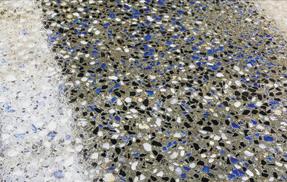

RUFF ROCK

Co-owner Ayden Tait says the business has been operating for more than a decade and over that time has built a reputation for specialising in the “whole-polish process”, including the preparation and the pouring of concrete to achieve the best polishedconcrete finish possible.







“The concrete we create is the finished product, we don’t just put products on top of concrete floors,” says Ayden.
Ruff Rock’s years of experience delivering superior polishing results across a range of projects throughout Canberra including the National Museum, Grease
“We are focusing on residential properties at the moment – new builds or renovations – and can offer products to suit your budget and needs,” says Ayden.
“Concrete is low maintenance and extremely durable and we provide a number of options both external and internal. I encourage people to give us a call and discuss their plans.”
Ruff Rock, call Ayden on 0456 644521 or visit ruffrock.com

‘HIA members from across the region were able to attend the gala celebration for the first time since 2019 due to the pandemic’
CORE Building Group and ART Group have picked up two prizes in this year’s top housing and kitchen & bathroom awards.
The companies were recognised in the Outdoor Project and Apartment Complex categories of the 2022 HIA-CSR ACT and Southern NSW Housing and Kitchen & Bathroom Awards.

Among other leading local winners were Modern Constructions and The Dept. Of Design, who were awarded the HIA People’s Choice prize and Light House Architecture & Science and 360 Building Solutions, won the GreenSmart Sustainable Home award.
Leading residential builders, designers and manufacturers gathered at Parliament House earlier this month to celebrate the prestigious awards, which showcase the best in residential housing, kitchens and bathrooms from Housing Industry Associa
DNA Architects and Preferred Builders
Riverina Home of the Year Xavier Higgins Building David Guinane
HIA People’s Choice Award
Modern Constructions and The Dept.Of Design
Custom Built Home of the Year
DNA Architects and Preferred Builders

Display Home of the Year Exceed Homes and Arkitex
GreenSmart Sustainable Home
Light House Architecture & Science and 360 Building Solutions Core Building Group and ART Group

Core Building Group and ART Group
Professional Small Builder / Renovator
PAH Innovative Construction
HIA Professional Medium Builder / Renovator
Professional Large Builder / Renovator
McDonald Jones Homes (Canberra)
Building Women – Small Business Management
Pichelmann Custom Building Services
Bellevarde Constructions

Country Home Xavier Higgins Building
Custom Built Home up to $500,000
Todd Gillard Homes
Custom Built Home $500,001 - $600,000
Wayne Carter Homes
Custom Built Home $600,001 - $700,000
Freedom Built
Custom Built Home $700,001 - $1.0 million
Classic Constructions and Quest Architecture
Custom Built Home $1 million to $1.5 million
DNA Architects and Brother Projects
Custom Built Home Over $1.5 million
Bellevarde Constructions
Custom Built Home Over $3 million
Preferred Builders and DNA Architects
Work Health & Safety
McDonald Jones Homes (Canberra)
Heritage Renovation Freedom Built
Host Trainer of the Year Paul Urbaniak
Kitchen Design MMM Interiors
Kitchen of the Year
Pichelmann Custom Building Services
New Bathroom Pichelmann Custom Building Services
New Kitchen Pichelmann Custom Building Services
Renovated Kitchen Status Living
Renovation / Addition Project > Over $500,001
Rettke Builders and Sketch Interiors & Design
Renovation / Addition Project > Up to $500,000
Status Living
Renovation / Addition Project of the Year Status Living
Residential Design DNA Architects
Residential Interior Design
Sketch Interiors & Design and Rettke Builders
Townhouse / Villa Development
Architects Ring & Associates and Antos Constructions
Townhouse / Villa of the Year
Antos Constructions and Architects Ring & Associates
The client wanted a beautiful, low-maintenance home that would allow them to ‘age in place’
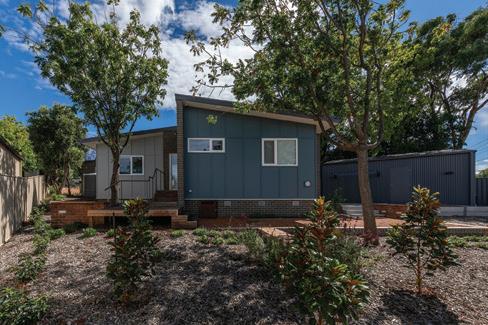

Light House Architecture and Science and 360 Building Solutions have won the GreenSmart Sustainable Home at the HIA ACT/Southern NSW Housing and Kitchen & Bathroom Awards 2022.


At 7.9 stars, Evatt House is predicted to require half as much energy for heating and cooling per square metre, compared to a 6-star home in Canberra.


With north to the front of the block (on the diagonal), on an upward slope, and views to the south, this one was a challenge!
The client was keen to take full advantage of the northern aspect to create a light-filled,
energy efficient, comfortable and healthy home. This was achieved by combining solar passive principles with a building physics focus on a well-insulated and sealed building envelope.
The client also wanted a beautiful, lowmaintenance home that would allow them to “age in place”.
The home sits back, modestly in the established streetscape and steps diagonally across the block to allow northern light to enter into three different sections of the home.
The floor plan is space-efficient and flexible delivering an accessible, single-level, twobedroom, two-bathroom and multi-room home in a 154 square-metre footprint. At under 200 square metres including the double garage, it has a significantly smaller footprint than a typical new Canberra home, but feels and functions
like a much larger home. The result is a beautiful, super-functional, solar-passive 7.9-star home in place of an incredibly leaky, cramped, south-west facing, energy-guzzling ‘60s house. This home has much lower embodied energy, and requires significantly less operational energy, than other typical new homes in Canberra. It meets the needs, and exceeds the expectations of our client.
At 7.9 stars Evatt House is predicted to require half as much energy for heating and cooling per square metre, compared to a 6-star home in Canberra. Given its space efficiency, and the reduction in resources used to create the home, this equates to a roughly 60 per cent reduction in carbon emissions and global warming potential compared to a typical new Canberra home. In addition, with the high levels of air tightness achieved, the environmental

impact of the home will be even further reduced.
With a 7.92kW photovoltaic system installed as part of the project, the home generates far more energy than it consumes across the year. The latest energy bill from February to May shows the home generated 1226 kWh of energy but only consumed 745 kWh.
A key innovation in this home is the achievement of such high-energyefficiency without any high-tech, expensive construction techniques.
In fact, we pride ourselves on achieving such incredible results with standard residential construction materials and methods. We do not use internal air barrier membranes or services cavities, which keeps construction costs much lower and provides excellent thermal bang-for-buck.

The People’s Choice Award from the HIA’s 2022 Housing and Kitchen & Bathroom Awards was taken out by “The Art House” constructed by Modern Construction.

Sitting in the leafy, tree-lined streets of Yarralumla, this modern home captures the shadows of the surrounding landscape on its sharp surfaces, giving the home an ever-changing appearance. Every aspect of the construction process was delivered with the highest level of experience and workmanship available to the project team.

The attention to detail and high level of skill the tradesmen possessed is evident throughout the home, from the perfection of the concealed clad garage door, rendering and steel work, to the excellent quality of tiling, joinery, and painting. The material selections were based on the client’s preference for simple external finishes and mainly
included vibrant white-coloured rendered finish with lightweight vertical cladding and cedar soffit linings, which were used to create subtle texture and warmth to the outside of the home.
The simple external building material palette and colour selection also serves to highlight the landscaping elements, including the feature stone retaining walls, tiled courtyard walls and the introduction of established planting as well as showcasing the pool and pond features, which are designed to be easily visible from all internal living spaces.





In a home like this, innovation comes from the planning, structural innovation and use of materials.
With a strong design and construction team onboard, all design challenges were able to be solved before construction. This allowed the team at Modern Construction to concentrate on their build quality and craftsmanship.
Canberra’s award-winning developer, Art Group and Core Building Group have been awarded winner of the Apartment Complex of the year for ACT/Southern NSW Region as well as winner of the Outdoor Project of the Year at the recent HIA Housing Awards 2022.

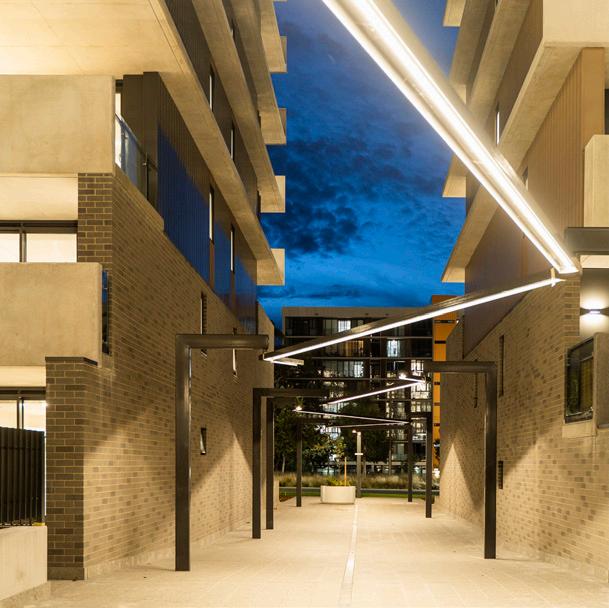

They were recognised for their work on the Mulberry development in the landmark Soho precinct of Canberra’s new gateway boulevard.
The Mulberry development embraces an innovative approach to construction, technology and interior design. The complex consists of 370 thoughtfully designed apartments.
It boasts more than 1000 square metres of resident amenities, including electric bike sharing area, secure parcel locker space, a stunningly landscaped ground level and a breathtaking rooftop entertaining area and pool.

Mulberry’s landscape design was based on interpretation of the existing heritage buildings and landscape that used to reside in this location. Inspiration was taken from the previous architecture which included classic arbores, timeless plants and unique patterns.
The combination of the design and formal patterning on the ground, is interrupted by the Corten planter boxes that angle out of the ground to create unique shapes and patterns that coincide with the Canberra landscape.
Above ground, the common areas are well thought out and pleasing to the eye whilst complimenting the view. The pool and barbeque areas are a luxurious addition.
– Gabe Szivek, Development DirectorThe combination of different varieties of building materials throughout the complex and methods work well together.
Wowing the judges was the exceptionally designed outdoor area, elegant external facade, unrivalled amenities and ease of access to the multiple rooftop spaces. They could not fault the outstanding quality finishes, attention to detail and craftsmanship throughout.
In relation to the outdoor award, the
Judges were impressed with the consideration in this project and the ease of access from the basement to the common areas to the rooftop gardens and pool was exceptional.
The project took approx. 30 months for construction to complete, with all 370 units being sold prior to unit titling being complete.
The Mulberry Project is Art Group first project for the Soho precinct so the design and built product needed to set a new benchmark for the Northbourne Avenue corridor projects.
project we take on we look for ways and means for a continuous improvement across everything we do


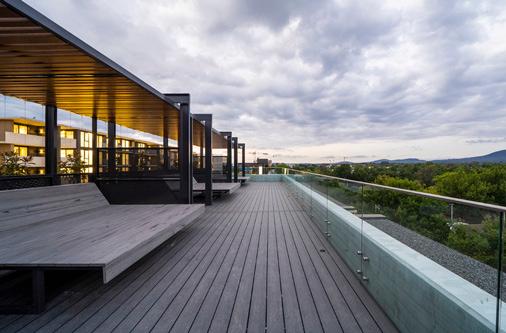



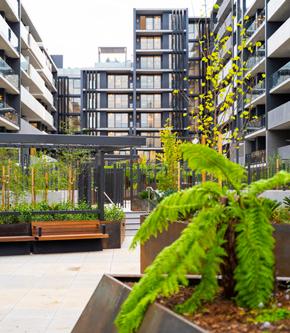


ORNAMENTAL onions (Allium giganteum) are great for a hot spot in the garden.
They can grow up to 120 centimetres with showy, tall stems and large, purple, globe flow ers. By adding colour and height to the garden, a mass planting can be very effective. However, the taller the stem, the more protection from the wind they will need.
Ornamental onions are not edible like their family counterparts in the Allium family, but not to be confused with edible giant elephant garlic (Allium ampeloprasum), which grows well in Canberra, too.
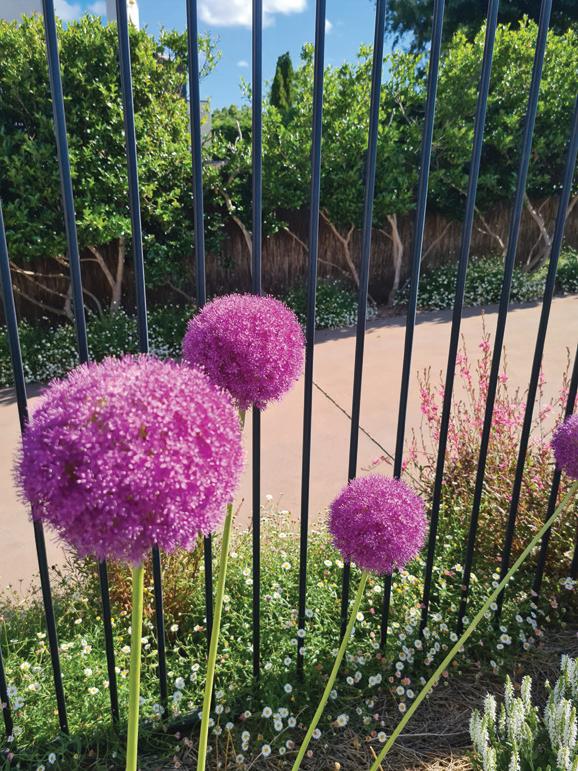
They are tough, drought resistant, cold tolerant and easy to care for but, as a bulb, they need good drainage, because they easily rot with too much water.
Once the flowering has finished, remove the spent stem as close to the base as possible and divide the clump now (and any other spring flowering bulbs, too).
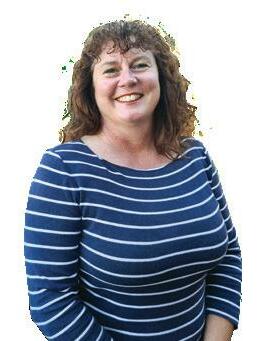
Use a fork and dig around the clump to remove as much of the soil around the bulbs as possible. Once out

of the ground, the bulbs can be teased from the clump of soil and replanted.
The colours for other allium species range across blue, pink, red and white. Dwarf varieties are also available.
All alliums have a pungent garlic smell and are useful to deter animals such as possums from eating plants.
MANY bulbs can be grown all year round in Canberra and one that provides a fantastic floral display is Hippeastrum, which grows well in pots and small gardens.


Its flowering times are around December in Canberra, which makes it useful for a table or garden display for the festive season.
Leaves, which appear after the flowers, are long, green and strappy. They like the soil a little acidic, so plant them where camellias grow. Hippeastrum and all amaryllis bulbs don’t like to be planted too deep and like to have their necks out of the soil with the pointy end up.
From planting, the bulbs take up to six weeks to flower but, if planted in a shady spot, flowering takes a little longer. Keep them moist, not wet over winter and fertilise bulbs while they are growing with a general-purpose bulb fertiliser.
WITH the good rains there still is moisture
in the soil to get more vegetables growing for harvesting after Christmas and into the end of summer.
The hot months of the year are best for grow ing, as seedlings, vegetables such as eggplants, capsicums, tomatoes, zucchini and lettuces.
Sow carrots, broccoli, cabbage and spinach now into punnets with sifted potting mix or worm castings. Sprinkle seed on to the surface of the mix and lightly cover with perlite or even sand.


Keep the seed moist and out of sunlight until germination, then move to sheltered light to grow. Water gently with a spray bottle.
Continue to harvest garden produce regularly to increase the yield of tomatoes and zucchinis. Continually harvest spinach and rhubarb leaves to encourage more growth. Spinach and rhubarb are great to freeze when there is a glut in the garden.



Leave a little space in the vegetable patch for winter-growing vegetables that like to be planted in late summer, early autumn and keep the space weed free and mulched.


WITH fruit trees now producing, fruit fly can be a problem in the orchard. The flies, attracted to ripe fruit, lay their eggs under the skin of ripening fruit, maggots hatch and feed, spoiling the fruit and causing it to rot and drop. Netting the trees will help prevent this before the fruit is ripe. Fruit fly traps work well and should be hung in the trees now.
jackwar@home.netspeed.com.au
A WRITER’S writer, who has become equally famous as a novelist and a tireless advocate for the arts, was named “CityNews Canberra Artist of the Year” at the 32nd annual ACT Arts Awards.
Nigel Featherstone was singled out for his eloquent writing and as a constant champion for his fellow Canberra writers and lovers of the written word.

“CityNews” editor Ian Meikle presented him with a certificate, prize money of $1000 and a F!nk studio jug.
Declaring himself “absolutely honoured”, Featherstone said: “I’ve lived in the ACT region for over three decades and it’s become my creative home as well as my geographic home.
“The combination of our incredible arts and cultural institu tions and relative peace and quiet has been essential to my work as a writer.”
Featherstone, whose novel “My Heart is a Little Wild Thing” was published by Ultimo Press in May this year, has been lavished with praise by critics around Australia for taking a remarkable look at Australian masculinity, for the
region poets Melinda Smith and CJ Bowerbird to found the spoken-word/music collective “Hell Herons”, which fuses lyrical language with songs.
In 2022 he worked at The Street Theatre as a dramaturg on CJ Bowerbird’s “Coward Punch” and as forum host for “Twenty Minutes With The Devil”.
His first full-length play, “The Story of the Oars”, was read in December 2021 as part of The Street’s “First Seen” program.
Although he has lived in Goulburn for the past 12 years, he identifies as a Canberra artist, is an active arts advocate and commentator in the ACT and has worked at ACT Writers since 2013, supporting and mentoring emerging writers, also connecting artists and community.
A familiar face on the wider Australian arts circuit, in August this year he was on the final panel at the Canberra Writers Festival and traversed northern NSW as part of the “Writers on the Road” regional tour. Then in October he led two residencies for the Terror Australis Writers Festival in Huon Valley, Tasmania.
The awards evening, hosted by the Canberra Critics Circle, also featured the circle’s own awards to ACT region artists living within a 100-kilometre radius of Canberra, which went to: Film producer, Shannon WilsonMcClinton.
Writers, Nigel Featherstone, Marion Halligan, Sandi Logan, Tabitha Carvan, Sarah St Vincent Welch and Kimberly K Williams.
Visual artists, Rory Gillen, Mi chael Armstrong, Judith Nangala Crispin, Annette Blair, Maryke Henderson, Anita McIntyre and Valerie Kirk & Harriet Schwarzrock. Dance artists, Ali Mayes, Jake Silvestro, Danny Riley, Australian Dance Party, and Ausdance ACT. Musical artists, Pip Thompson, Fred Smith, Luminescence Cham ber Singers, Ronan Apcar, Rachel McNally & Michael Dooley and Canberra Symphony Orchestra.

Musical theatre artists, Andrew Finnegan, Echo Theatre Company, Stephanie Bailey, Ylaria Rogers and Rachel Reid (Jazida).
Theatre artists, Meaghan Stewart, Jarrad West, Chrissie Shaw, Max Gambale, Christopher Samuel Carroll, Dylan Van Den Berg, Amy Kowalczuk and Andrea Close.
Hub in Kingston, conceived during the covid lockdown when she and the direc tors of three other theatre companies joined forces to secure the future of serious theatre practice in Canberra.

A performing artist at the very height of her powers, Vickery, the judges believe, takes hold of the mature parts presented to her now and interprets them with a great deal of complexity and sophistication.


An accomplished Russian linguist who has translated plays by Anton Chekhov and Maxim Gorky into hotly sought-after English-language playscripts, she also spent many years working as a jobbing actor for TV series, including “All Saints” and “A Country Practice” (three times in three different roles) and in stage dramas, once playing 13 characters in the Sydney Theatre Company’s produc tion of “Nicholas Nickleby”.
Moving to Canberra to pursue her
foray into community theatre), then as actor-director with Everyman Theatre, Pigeonhole Theatre and her own newly formed Chaika (Russian for “seagull”) Theatre, she became a driving force in the Canberra theatre scene and a model to younger actors.
The late Helen Tsongas, who would have been 44 in November this year, was a dramatic actor memorable for tragic roles who was equally admired for her finely-tuned comic roles in comedy. She worked at arts ACT for many years and then moved to the then Commonwealth Office for the Arts.
She died with her husband in a motorcycle accident shortly after their marriage and her family has established this award in her memory.
The Helen Tsongas award takes the form of a cheque to the value of $1000 and a certificate going to the best Canberra actor of the year, with no restrictions on age or gender, as judged by the theatre panel of the Canberra Critics Circle.
PERHAPS the most famous film director of all time has taken aim at streaming.






In a controversial interview with “The New York Times”, Steven Spielberg criticised the way platforms such as Netflix, Disney Plus and HBO Max (Binge in Australia) aren’t giving films theatrical releases.

“The pandemic created an opportunity for platforms to raise their subscriptions to record-breaking levels and also throw some of my best filmmaker friends under the bus as their movies were unceremoniously not given theatrical releases,” Spielberg said.

“I think older audiences were relieved that they didn’t have to step on sticky popcorn. But I really believe those same older audiences, once they get into the theatre, the magic of being in a social situation with a bunch of strangers is a tonic.”
The three-time Oscar winner is not the first filmmaker to bemoan the loss of the cinema experience to streaming.
Director of “The Dark Knight”’ and “Interstellar”, Christopher Nolan last year chewed out HBO Max, saying the company was treating filmmakers poorly by not giving movies a run in the cinema.
“Wonder Woman” director Patty Jenkins has continuously opined that movies that go straight to streaming “don’t feel like real films” and that the model “doesn’t work for establishing legendary greatness”

Hell, Martin Scorsese even wrote and published a whole essay on why streaming devalues the art of cinema.

movies has now turned into a night at home on Disney Plus.
Spielberg’s concerns are justified. While there’s an allure to the ease of putting on a new flick at home, many would agree it’ll never beat the experience of seeing it on the big screen. But there is an important flipside to this argument.
Thanks to streaming, Spielberg’s unrivalled filmography is more accessible today than it’s ever been, especially for a new generation.
Incredible films such as “Schindler’s List”,
subscribed to, odds are they’ll have access to at least one of these legendary movies.

Just last week I got to tick “Close Encoun ters of the Third Kind” off my to-watch list and was awed by the film that’s just shy of 50-years-old. I can only imagine what it would have been like in the cinema, but I’m just glad I got to have the experience at all.
Binge even features a documentary on the famed filmmaker himself. The eponymously titled “Spielberg” tracks life and career of the ideas that made him a household name.

“I don’t know anybody that wouldn’t like their movies to be shown on a big screen,” said Spielberg.
While there’s some truth here, streaming gave people the chance to enjoy films during a time when they weren’t allowed to go out and see a movie, let alone other people.
The release of long-anticipated movies at home offered a small sense of normalcy in an increasingly strange world.
Streaming, paired with the pan demic, created a new model of choice for the consumer. What we’re likely to see going
experience a new film, a movie that goes straight to streaming doesn’t make it any less of a movie.
Amidst the stress and sadness of lockdown, a good film offered many people a chance to escape, if only for a few hours. If that isn’t the magic of movies at work, then what is?
THE list of German-born director Maria Schrader’s filmography shows an acting career that began in 1988 in six TV series and 47 films and directing one TV series and five features.
The screenplay by English writer Rebecca Lenkiewicz was based on the work of Jodi Kantor (Zoe Kazan, granddaughter of Elia Kazan who directed some great movies in his day) and Megan Twohey (Carey Mulligan), the two “New York Times” journalists who investigated the events leading to the imprisonment of Harvey Weinstein and collaborated on the book of the same name.

“She Said” is built from words set in a collec tion of images without which the words would find it hard to mean anything. The amalgama tion of words and images tells the story of the #MeToo movement that was built by people who shared experiences but for years had been afraid to speak up because they thought that they might not be believed.

That unwillingness to speak publicly hindered the publication of the “New York Times” article that first truly exposed Weinstein. And that’s what the film is about.
“She Said” runs for 129 minutes. Watching it is time well spent, delivering tensions, failures and
successes, names of memorable movie and media people living gently powerful dramatic lives retelling some important journalism and movie industry history. Its poignant moments offer inspiring content, a straightforward and competent look at a disturbingly true story. Many people may find the shared title of book and film to be enigmatic. There’s a children’s song about a pretty girl going a’milking and a bloke trying to get off with her until she tells him that she’s got no money, her face is her fortune. Every line she speaks in the song ends with “sir, she said”. It harks me back to drying the dishes that my father had just washed and singing together as we went. And in my mind, there is a connection, however much obscure.
In all cinemas
WATCHING writer/director Romuald Boulanger’s whodunit (reported to be a remake of a Korean film “Midnight”, which I don’t remember having seen) set up tensions in my mind that sustained my interest most of the way through its 104 minutes.
Is it any good? It doesn’t fly any flag suggesting that it’s not to be taken seriously. When it reveals the purpose of its true outcome, the screenplay invites the audience to make a refreshing choice between dramatic relief or clever comedy. Either way, it would be a spoiler so I’m not going that far.

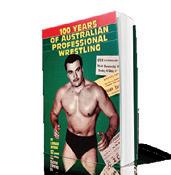
What is driving the heard-but-never-seen Gary (Paul Spera) who’s threatening to set off a bomb in radio station KLAT because overnight talk show host Elvis (Mel Gibson) had driven a former female employee to suicide after her stint on the show?

And how is Gary managing to foresee Elvis’ every at tempt to find him and put a stop to the interference that he’s causing to Elvis’ self-esteem and personal comfort?

That summation heralds entertainment values which “On the Line” delivers with energy enough to justify itself until the unexpected moment when it reveals the genuine purpose of all its preceding screen time.
That moment certainly delivers a surprise. Is it worth that change of direction? Or is it a swizz seek ing to influence its merit in the filmgoer’s judgement by getting that far with nary a hint of its intention? Does it deliver value for the price of your ticket? There’s only one way to find out.

At all cinemas

WALLAROO sounds like a song that Abba might have recorded in the ‘70s. But it’s actually a superb region of hills and valleys, a green patchwork of bush and cultivated paddocks west of the Barton Highway where the ACT border folds into NSW.
On a sunny spring day where the rain finally let up, mate Tom and I headed out to the Hills of Hall. We visited two of the three wineries that sit high and proud in this scenic locale: Brindabella Hills Winery and Pankhurst Wines. We’ll return one day soon to experience Surveyor’s Hill vineyards.

The Visit Yass Valley website tells us that Wallaroo is in fact named after “the very shy and very rarely spotted woolly black wallaby”. The canopy as we looked down from the terraces at Brindabella Hills Winery shows areas of dense bush that hug the Murrumbidgee River where these wallabies could hide with impunity.
Later, Allan Pankhurst tells us that the dense bush also hides scores of deer. It is a wild and woolly area all right.
But that image contrasts with the commercial reality that is Brindabella Hills Winery. The owner, Michael Anderson, indicates to us that the restaurant is booked out solidly every Saturday and Sunday and we rub shoulders with a large number of people who are dining or wine tasting inside or who are on the grassy terraces fighting the stiff breeze that has arrived with us. It hasn’t put off the people outside who are palpably enjoying themselves.

Brindabella Hills has a unique approach to wine tasting. Derek Phillips, of Fudgemental, is a chocolatier who has matched a range of different flavoured chocolate with each wine on offer. For me, the most interesting match on the day was the macadamia pear chocolate that completely
changed the taste of the 2021 Marsanne. Before melting the chocolate on the tongue, this wine had a distinctly herbaceous flavour, almost the presence of a bouquet garni, that was displaced by a more floral mouth feel after the influence of the chocolate.
The wine that for me epitomises Brindabella Hills niche is the 2021 Sweetheart. This is a blend of late-harvest riesling, semillon and viognier that has a sweet finish. The cellar hand who presented the winery’s list to us, Jeremy Black, said of this blend: “We get a lot of young girls who have never tried wine before and they love this one.”
The atmosphere and the clientele at Pankhurst Wines is completely different. It has a more family, homely appeal with views of paddocks framing distant hills rather than the Brindabella Hills vista of gorges and the rolling brown river as it wends its way to Wagga Wagga.
Here we sat at a table constructed by Allan Pankhurst from an old wine barrel, rustic and practical, fitting into the feel of a visit to a kindly uncle who owns a farm where you can have fun.
“At the time, all I could see were sheep bones and dust and dead bodies.”
Her comments underline the transformation that they have brought to the property with its ordered paddocks and vines that produce some memorable wines. I’ve already written in praise of the 2019 Arneis which we tried again and recalled the way this wine finishes so cleanly with a good weight and mouthfeel. We also especially enjoyed the 2019 cabernet sauvignon with a great balance of fruit and oak, a wine that won a silver medal at the Cowra Wine Show this year.
The Hills of Hall are worth a visit.
What’s funnier: mountain ranges or forests? Moun tains, of course – they’re hill areas
“She Said”... it’s time well spent, delivering tensions, failures and successes.

SRI Lankan food is an explosion of colour, spices and flavours. Banana Leaf restaurant, which has had various homes over the past few years, has now settled once and for all in the heart of Canberra on Akuna Street, promising an intriguing blend of Sinhalese, Tamil, Moor, Dutch and Malay tastes and textures.
The massive wall of creative masks makes for an impressive entrance and the décor is light and warm with wooden accents and dining over two levels.
If sharing is a priority, talk to staff about the best selections since not all dishes lend themselves to this style of eating. That’s not necessar ily a problem; it’s a consideration (for some diners).
Banana Leaf focuses on authentic dishes, including the entrees. The chicken pan roll was a great start ($16 for three) and the minced chicken curried at just the right level. The chicken, combined with potatoes, were wrapped in a soft roll and the trio attractive on a stylish, mottled black plate. The dish
of mayo on the side featured chilli, but not super-hot chilli (by design).
The “devil sauce” with the Yaka Bao was zingy and we chose tofu instead of chicken or fish ($16 for one).
At the top of the menu is the promise of “fine-ish dining”. Am not clear on the precise definition of the phrase, but mains designed
To make life easier with the three of us wanting to share and test multiple dishes, we ordered the Traditional Sri Lankan Village Set. It’s a signature for Banana Leaf and is $100 for two. It’s massive and, after entrees, was more than enough for the three of us to explore.

The set only has one meat
(chicken or beef) or fish dish, which satisfied us. It’s a veritable feast and delicious. Items include string hoppers or savoury rice. The set is loaded with vegetables, spicy lentils, a wonderful egg curry and devil potato. Pickled eggplant packed a punch, the tempered cashes with anchovies were addicting, and who can go wrong with crispy, fluffy roti, crunchy pappadum and butter chilli?
Mains include Seeni Sambol gnocchi ($30), Kalu Pol pork with truffle mash ($35), spice marinated grilled barramundi ($35), curry glazed duck ($36) and king-prawn curry ($42). Other entrees include a chilli-honey squid ($18) and a tempura-prawn taco ($17).
We enjoyed our meal with a Hunter Valley verdelho.
One major concern was the timing of the arrival of our food. Pretty well all dishes were brought out together, which was overwhelming, not only visually and mentally, but it sure crowded the table.
By Helen MusaTHE silly season has well and truly hit Canberra’s arts scene. “Finucane & Smith’s Travelling Dance Hall” is coming to town. It’s a cabaret jam-packed with songbirds and showgirls, disco divas and dancing stars, local legends, burlesque twirlers and go-go groovers. Tuggeranong Arts Centre, November 30-December 3.
“A Celtic Christmas” billed as a feel-good Irish music and dance feast will feature a company of more than 15 Irish dancers and musicians, including a seven-time world champion, Alliyah, and “Donegal Lord of the Dance” stars, twins Niamh and Gavin Shevlin. The Q, Queanbeyan, November 27.

“THE Chaser’s” Charles Firth, “The Shovel’s” James Schloeffel and ABC TV’s Mark Humphries have teamed up again to stage “The War on 2022”, an end-of-year live show with Australia’s leading satirists. Joining the tour will be Gabbi Bolt, a musical comedian who’s become one of Australia’s biggest TikTok stars. Firth says: “This year, we’ll touch on hilarious topics such as the war in Ukraine, the impending climate apoca lypse, destruction of women’s bodily autonomy in

“A Celtic Christmas”... The Q, Queanbeyan, November 27.

America and how to be as charismatic as Peter Dutton.” Canberra Theatre, November 30.
“A VERY Canberra Comedy Festival, Christmas 2022” will be a two-hour comedy gala event featuring some of the premier acts from Canberra Comedy Festival’s coming 2023 event. Canberra Theatre, December 3.



ON a more solemn note – but always great fun for music lovers – Canberra Choral Society heralds the festive season with Handel’s “Messiah,” performed under the baton of Graeme Morton, Llewellyn Hall, December 3.
AN exhibition called “Pictures of You” adopts a unique approach to self-portrayals of people with physical and mental health issues. At Belconnen Arts Centre, December 2-February 5.
ALSO marking International Day of Persons with Disabilities as the exhibition does, the Stellar Company and Liz Lea present “A Stellar Lineup”, involving Can berra’s most engaging community dance companies celebrating inclusion and excellence, Belconnen Arts Centre Theatre, December 2-3.
ARIES (Mar 21 – Apr 20)
The Sun, Mercury and Venus are visiting your adventure and exploration zones. However, Mars – your power planet – is in retrograde mode. Which means you may be feeling tired, worn-out, impatient and/or irritable. So travel and holiday plans are best put on hold until after January 12. Then you can “Sail away from the safe harbour, catch the trade winds in your sails. Explore. Dream. Discover.” (Quote from this week’s birthday great, writer Mark Twain.)
TAURUS (Apr 21 – May 21)
Are you worrying about money? This week (with impulsive Mars reversing through your $$$ zone) avoid being uncharacteristically rash with cash and credit. Mercury urges you to increase your financial literacy, as you swap spending for saving, and nurture your nest egg for the future. With Uranus still transiting through Taurus, your mantra for the week is from entertainer Bette Midler (who turns 77 on December 1): “Cherish forever what makes you unique.”
GEMINI (May 22 – June 21)
Gung-ho Geminis are fantastic at starting things but not so good at finishing them. This week’s stars encourage a light-bulb moment when you have the enthusiasm to get an ambitious idea off the ground. And steady Saturn boosts your patience and persistence. Which you’ll certainly need, as Mars continues retrograding through your sign. Don’t believe everything you hear on Friday when Neptune scrambles communication and confuses conversation.
CANCER (June 22 – July 23)
With the Sun, Mercury and Venus visiting your wellbeing zone, learn to love the things that are good for you. Like nutritious meals, regular exercise, relaxing in nature and lots of rest. (Crabs love curling up in bed and need plenty of good quality sleep.) The simple things in life are definitely the best! Like preparing a home-cooked meal, having an early night, enjoying a funny conversation with a child, or picking fresh flowers to put in your home or office.
LEO (July 24 – Aug 23)
This week a long-cherished dream may need to be re-imagined and reworked so that it better suits your current situation. Rather than seeing it as a disappointing setback, clever Cats will perceive it as an exciting new challenge. You’re keen to communicate about a wide range of topics, as you share ideas with family and friends. But, with Neptune squaring Mercury and Venus, avoid spilling secrets or saying something that’s inappropriately ambiguous.
VIRGO (Aug 24 – Sept 23)
Are you suffering from a crisis of confidence? Is your perfectionist streak running rampant? The more you over-think situations and try to make everything ‘perfect’, the more you will worry and obsess. Don’t waste time comparing yourself (and your talents) to other people. You need to run your own race… slowly at the moment, as Mars reverses through your career and life-direction zones. Saturn cautions you to be prudent, patient and persistent.
LIBRA (Sept 24 – Oct 23)
Librans love things to run efficiently and smoothly but (courtesy of retrograde Mars) there’s unpredictable planetary energy about this week. So drop the perfectly planned schedule and just take things as they come. Some possible scenarios? A relationship with a relative, colleague or neighbour could veer off in a confusing direction. Or something you post on social media could receive a disappointing response. Which will certainly keep you on your toes!
SCORPIO (Oct 24 – Nov 22)
Scorpios can have trouble trusting other people at the best of times. And now –until January 12 – Mars is reversing through your trust and intimacy zones. So a loved one could let you down or an old resentment could resurface. Also, if you don’t feel comfortable asking someone for help then don’t. Your motto for the week is from birthday great, writer Louisa May Alcott: “I am not afraid of storms, for I am learning how to sail my ship.”
SAGITTARIUS (Nov 23 – Dec 21)
The Sun, Mercury and Venus are all visiting your sign. Which highlights your positive traits (being optimistic, generous and curious) and your negative traits (being impatient, bossy and belligerent). But your best quality is your lively sense of humour, so make sure you’re using it! Inspiration for the week is from birthday Sagittarian, writer Mark Twain (who was born on November 30, 1835): “The human race has one really effective weapon and that is laughter.”
CAPRICORN (Dec 22 – Jan 20)
It’s a good week for Capricorns, as Saturn (your patron planet) makes positive aspects with Mars, Mercury and Venus. Which favours planning, goal setting, problem-solving, studying, long-term friendships and financial matters. But remember that Mars is reversing through your work and wellbeing zones until January 12. So – when it comes to your job and your health – slow down and be less bossy and more patient. Hasty is out and humble is in!
AQUARIUS (Jan 21 – Feb 19)
Retro Mars opposes Mercury and Venus (in your hopes, goals and wishes zones). So it’s time to focus on your aspirations for the future. But you must be patient and persistent about putting plans into action. Good things will eventually come to Aquarians who wait! As birthday great Louisa May Alcott wrote: “We all have our own life to pursue, our own kind of dream to be weaving, and we all have the power to make wishes come true, as long as we keep believing.”
PISCES (Feb 20 – Mar 20)
This week expect a dash of discombobulation, as Neptune (your boss planet) squares Mercury and Venus. So communication could be puzzling and relation ships could be a confusing minefield. With Mars also reversing through your home zone, expect a domestic drama and/or a family fiasco. The more stubborn you are, the more persistent the problems will be. Philosophical Fish will wind down, relax and go with the (sometimes disrupted) flow.
 Copyright Joanne Madeline Moore 2022
Copyright Joanne Madeline Moore 2022
Across
What is a small room for clothing, utensils, etc (6) 8 What are charges incurred? (8) 9 Jerusalem is the capital of which S W Asian republic? (6) 10 To invest with sovereign authority, is to do what? (8) 11 When one is dealing effectively with a situation, one is doing what? (6) 13 To express in words again, is to do what? (8)
16 Name a trapezoidal zither with metal strings. (8)
19 Which colour lies between blue and violet in the spectrum? (6)
22 What broadly is another term for an atheist? (8)
24 What is anything conducive to sumptuous living? (6)
25 Name another term for the herb, paris. (8)
26 Stockholm is the capital of which N W European kingdom? (6)
3
2
Name another term for a lariat. (5)
Name a title for a Hindu religious teacher. (5)
4 What is being replaced by the email? (8)
5 What is a mark made by foreign matter? (4)
6 What do we call a sleeping person who breathes harshly and noisily? (6) 7
Name a popular court game. (6) 12 Name a stitch used in hand knitting. (4) 14 Which Athenian political leader was responsible for the Parthenon? (8)
15 Which prefix means “against”? (4)

17 What, colloquially, are racecourse tipsters? (6)

18 Which herb has trifoliate and dense flower heads? (6)
20
Name a large metal pot in which stew, tea, etc, is made. (5)
21 What is a narrow cleft with steep, rocky walls? (5)
23 Name an ancient ruined city in N W Asia Minor. (4)



When selling, there are various method of sale to consider.
The “for sale” process is known as “Private Treaty” and is where you put a price, or a price with a plus, or “by negotiation” or a price range showing a price range. Personally I only use “by negotiation” straight after an Auction while I’m negotiating. I never use it at the start of a campaign as price is always the first buyer question and when you know the range, why not reveal it?
Another method of sale is Auction. Agents either know how to do them well, or are not confident and avoid them. When you’re a seller, it is the only way of truly finding out the market value of your home. It is very transparent, only costs $550 more than the private treaty process, and every week we get unanticipated results.
In the last month alone, Blackshaw has achieved five record prices by using the Auction process - in what some people may say is not the running market of last year.
No agent can accurately predict what your home will sell for. We will have a range, but that’s it. Every family home has variables and unique features, and the more unique features you have, the harder it will be to price.

Even in today’s market, we are still selling at/over 66% using the Auction process. Even if as a buyer you might not like Auctions, as a seller it is often your best method of sale.
The positive is you can still sell during the campaign with a pre-Auction offer. Those that don’t sell on Auction Day find the buyer in the next fortnight. This is still statistically quicker than a private treaty process, that can drag on as it doesn’t have a timeframe.
I’m currently selling a one bedroom in Lyneham as private treaty, because there is enough evidence of what it will sell for, plus my market is predominantly first home owners. However my Red Hill, Griffith and Deakin listings next year over $2m are all Auctions. The method of sale has to suit the property to achieve the best result.
Every time I see a property with a fixed price selling in the first week, I feel it is nothing to brag about - it means the owners got a sale, but is there proof that it was the premium sale price?
If you’d like a chat on your best method of sale, please call me for an appraisal.
